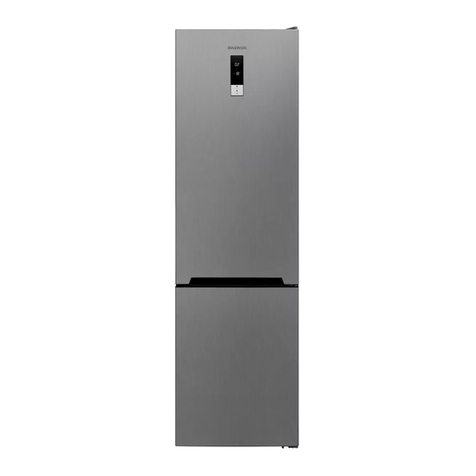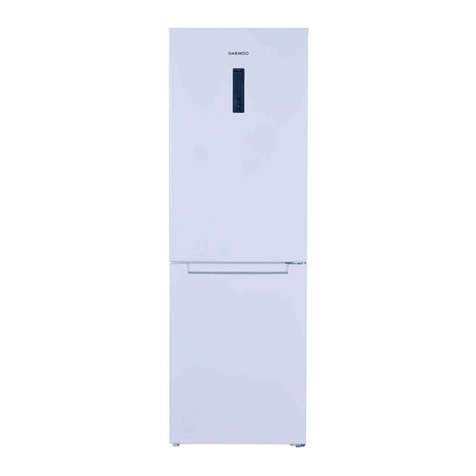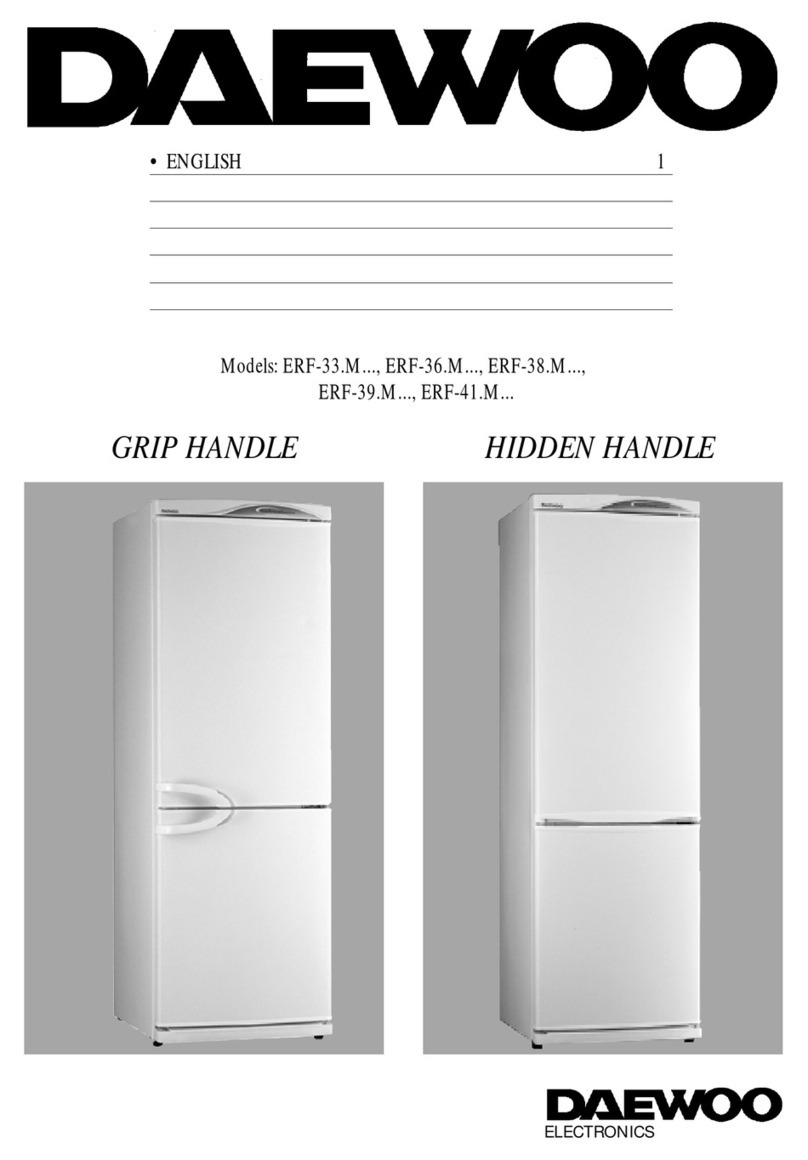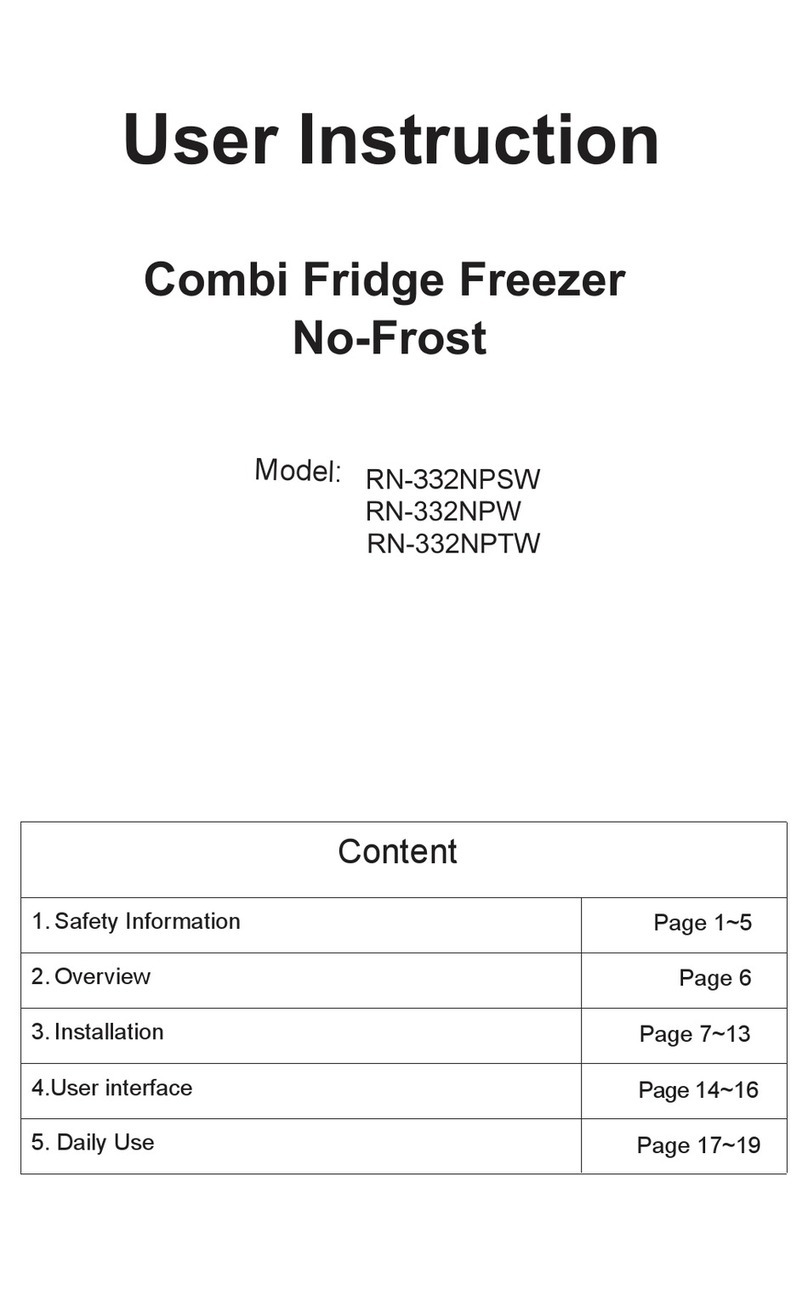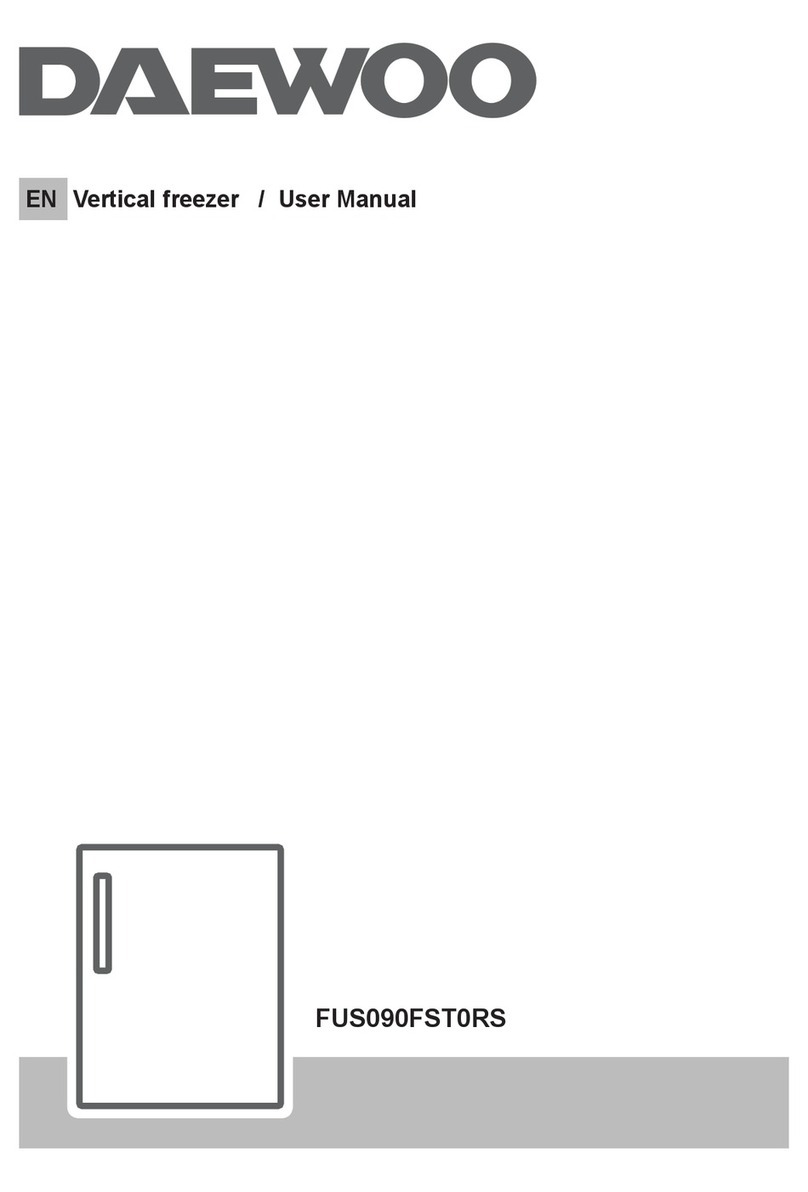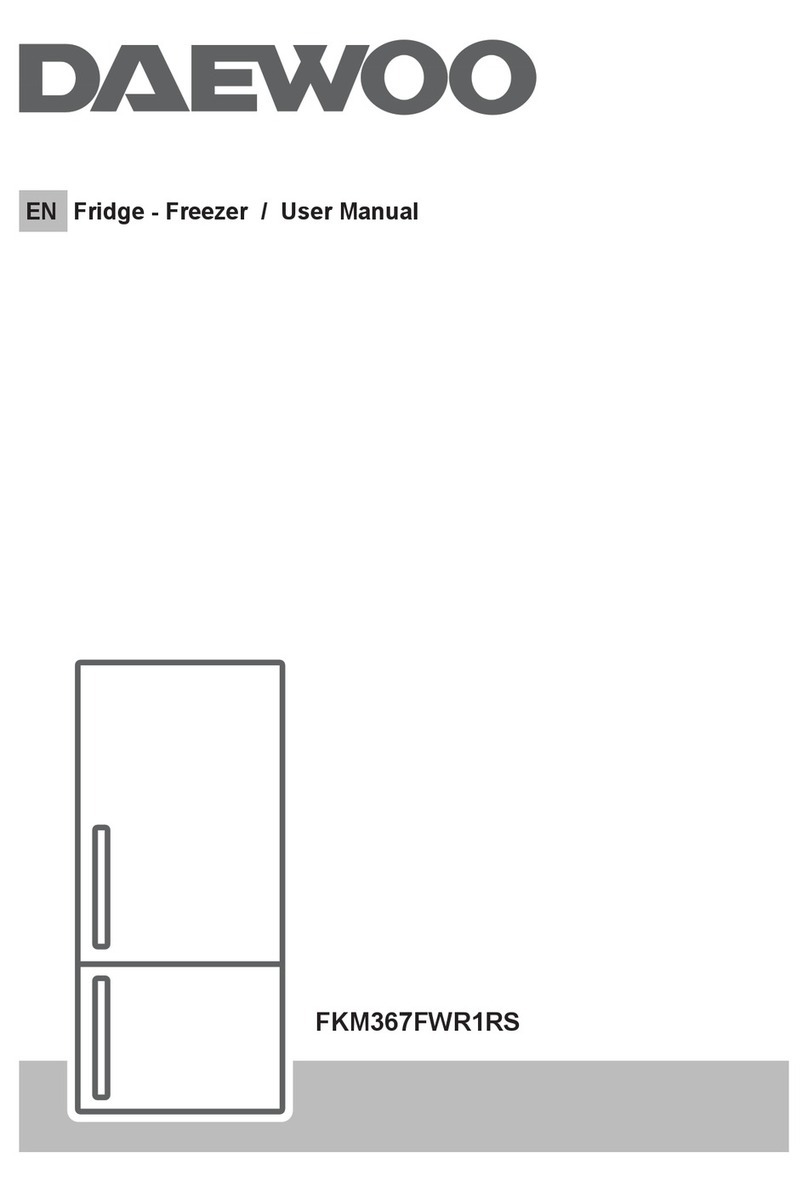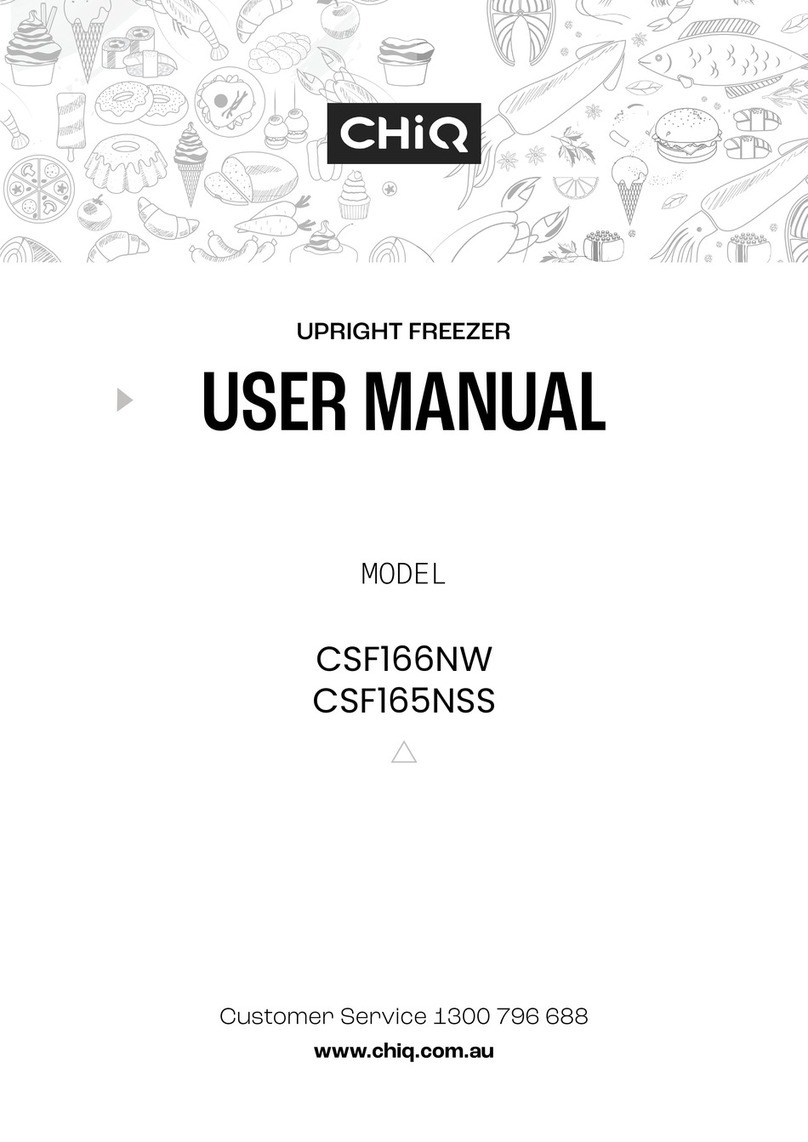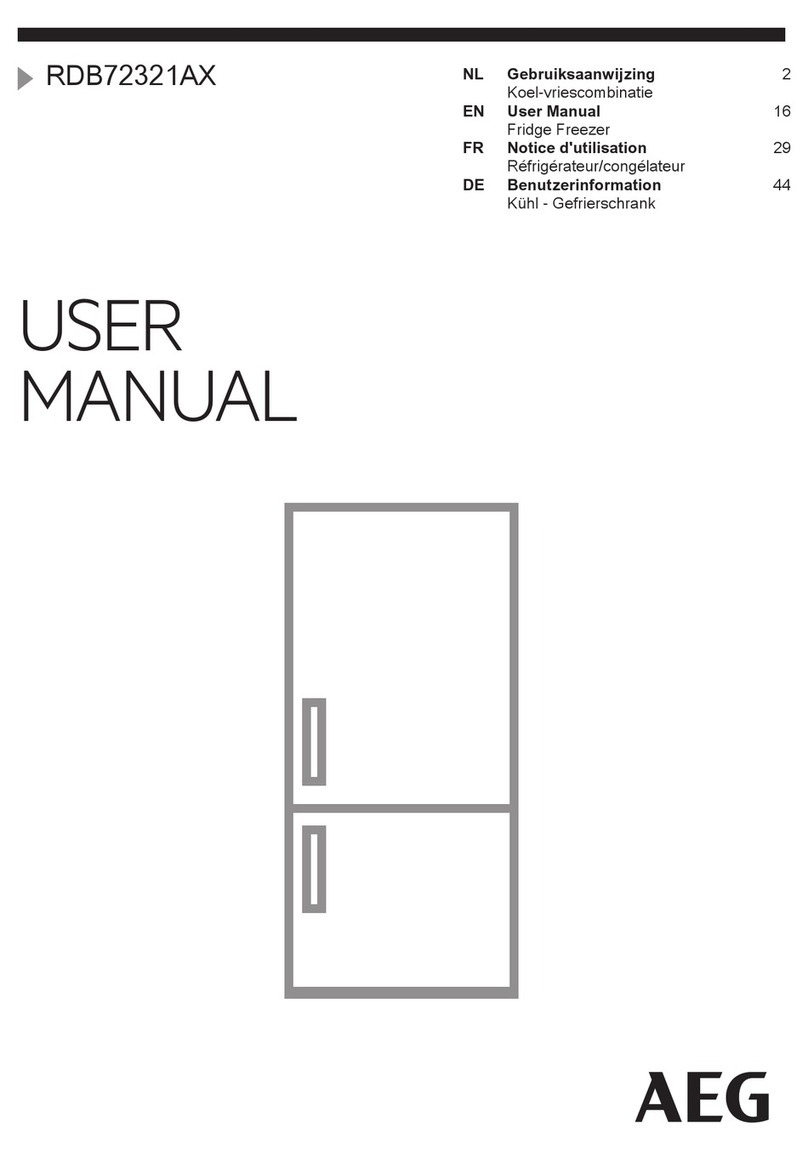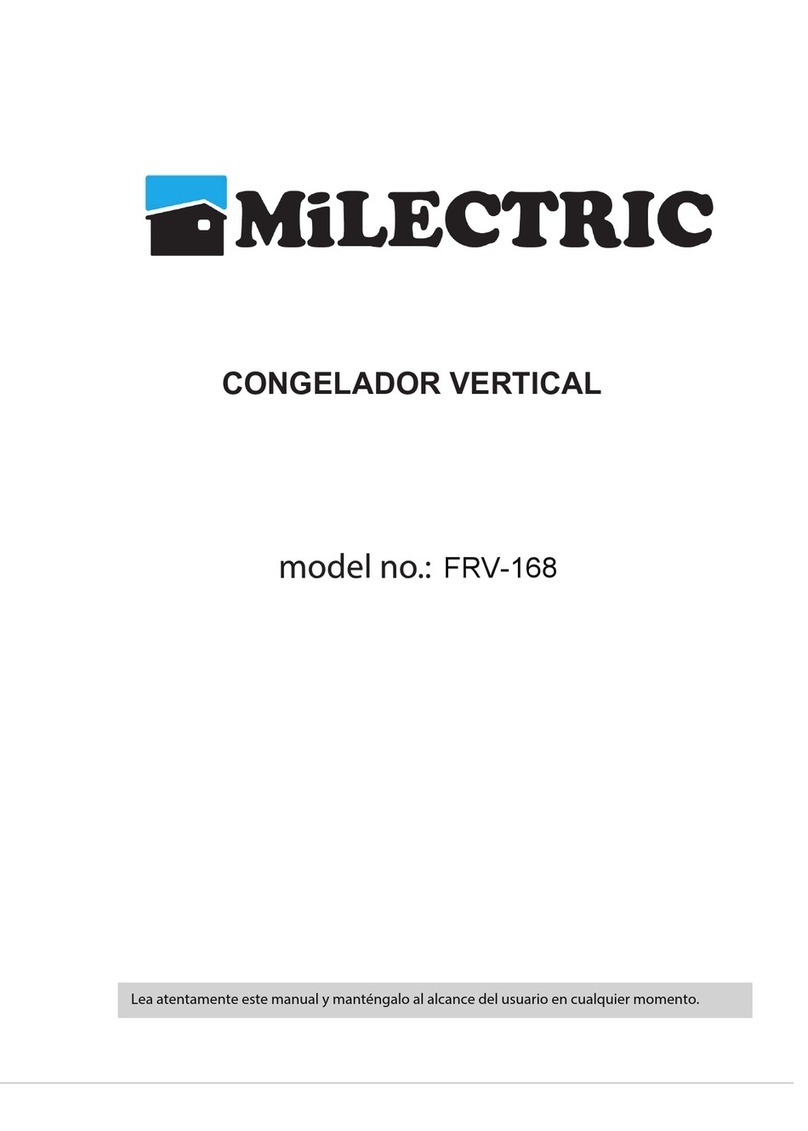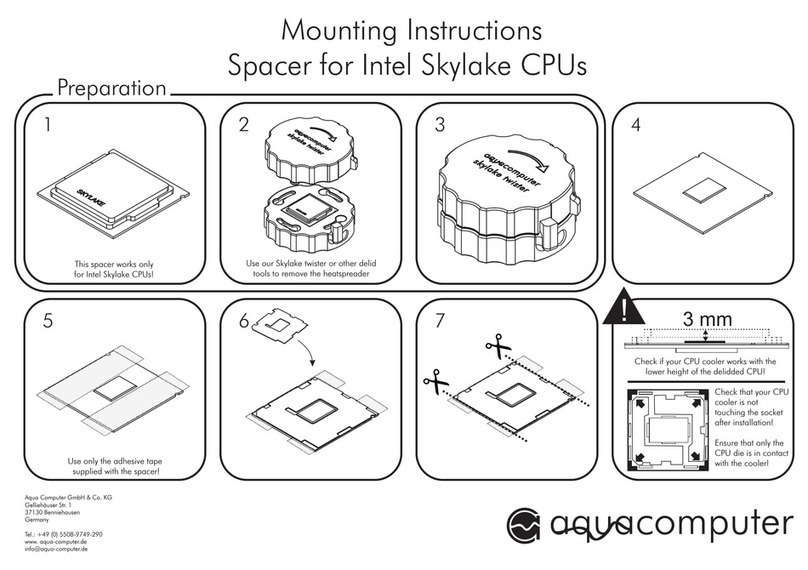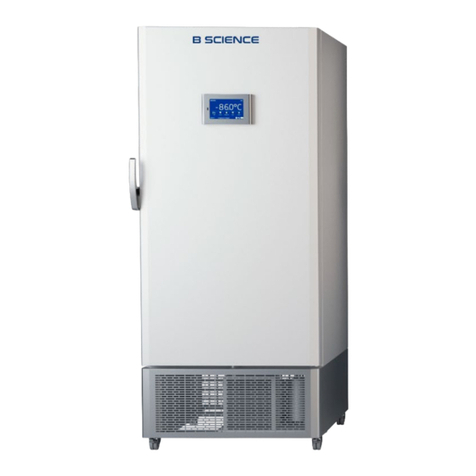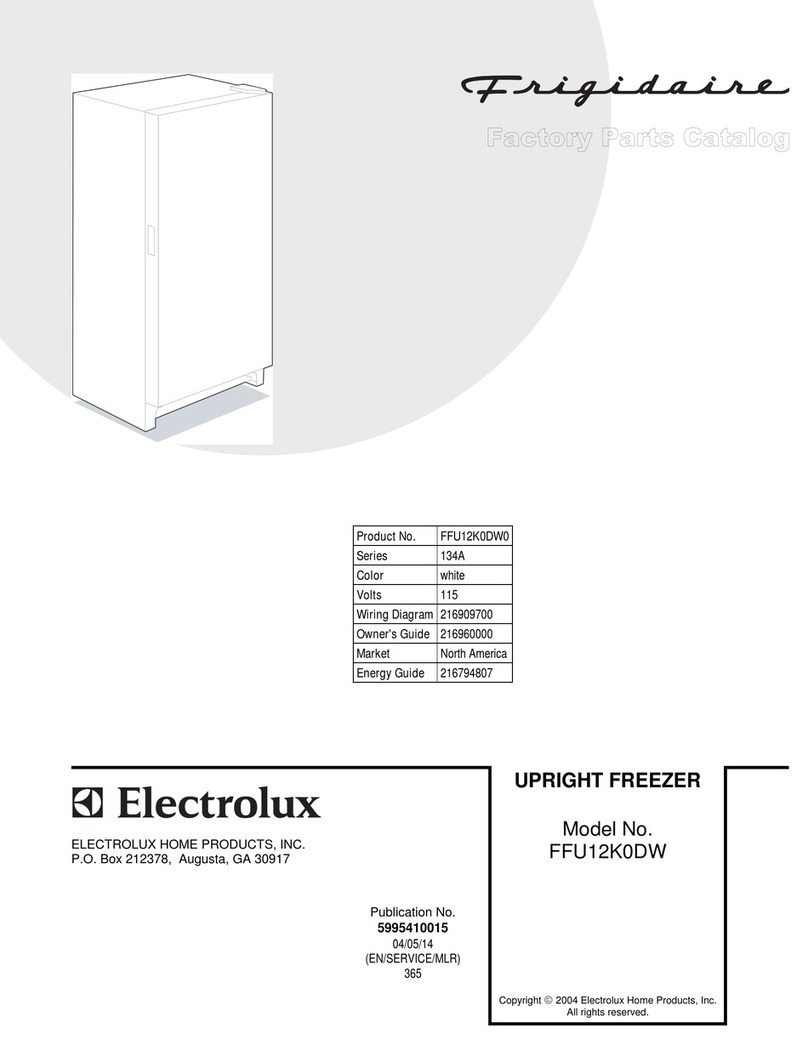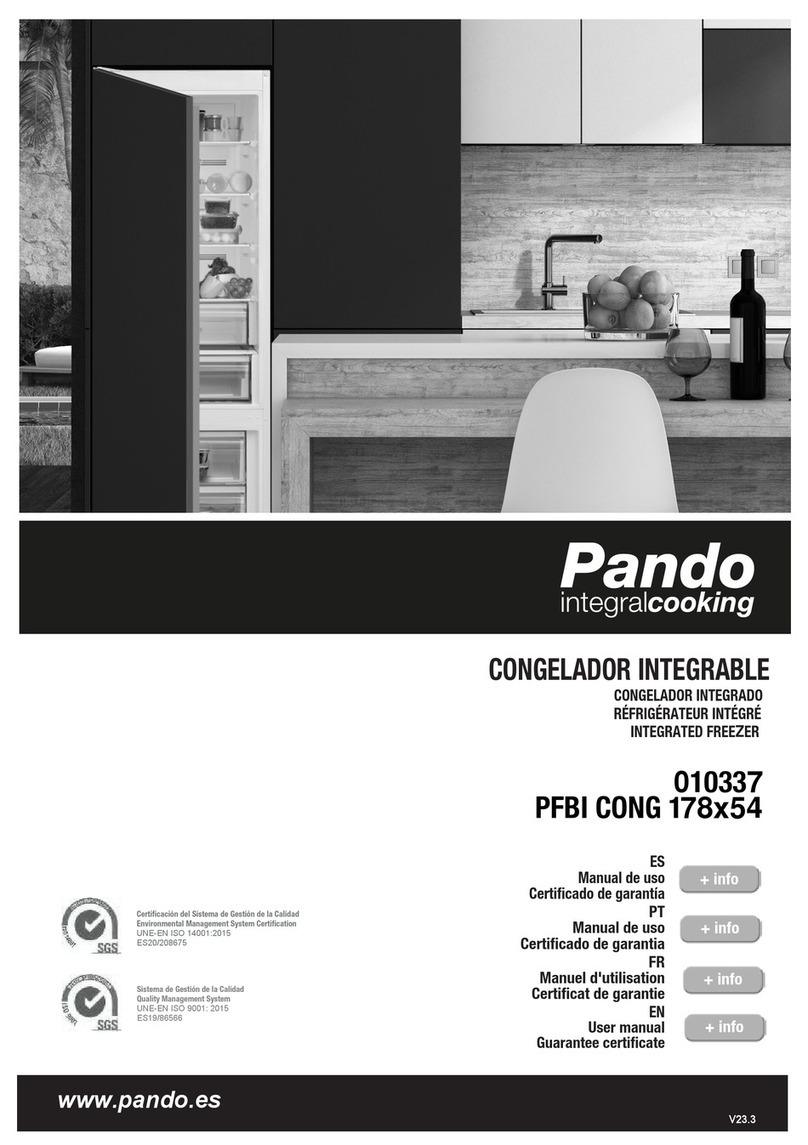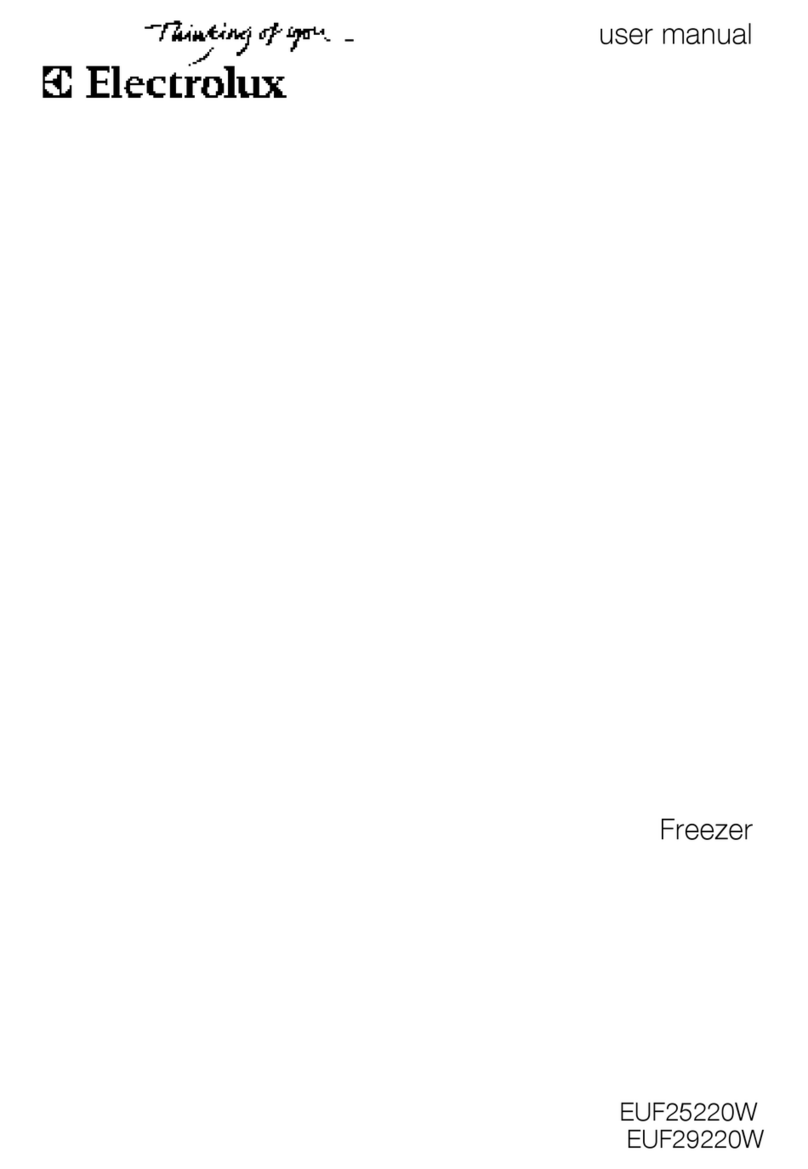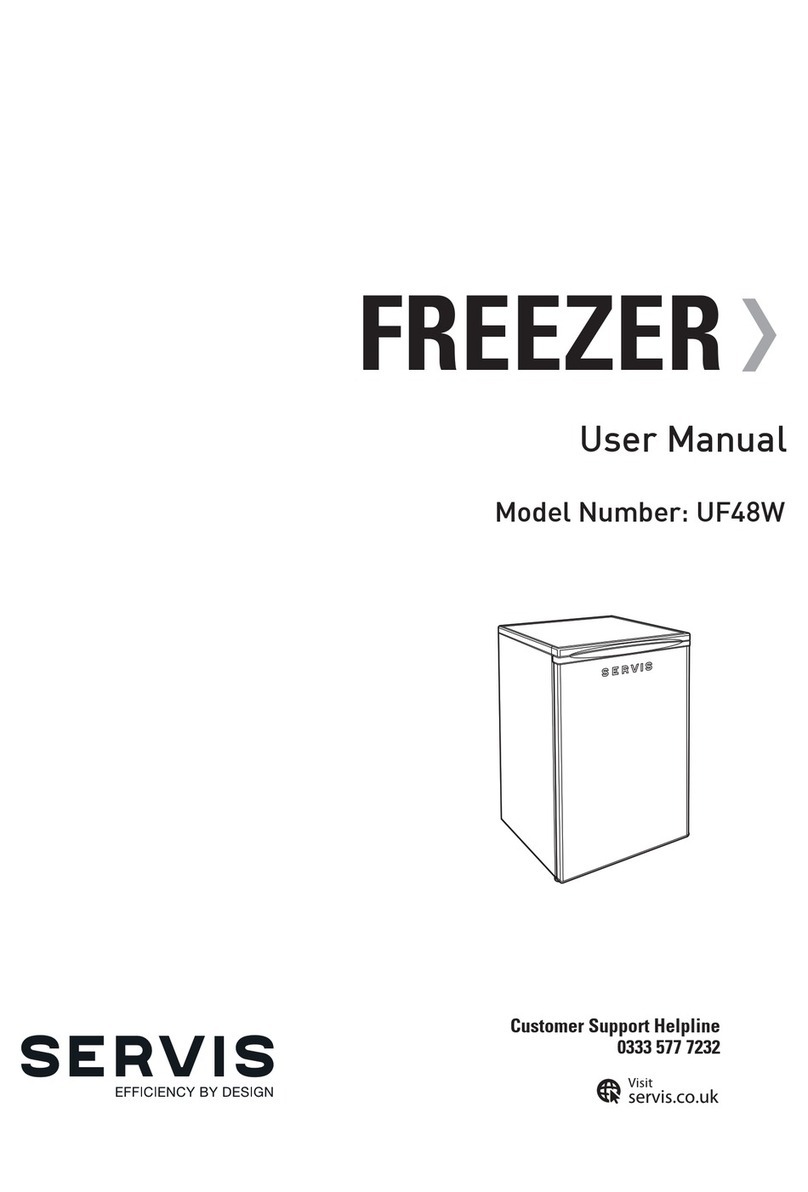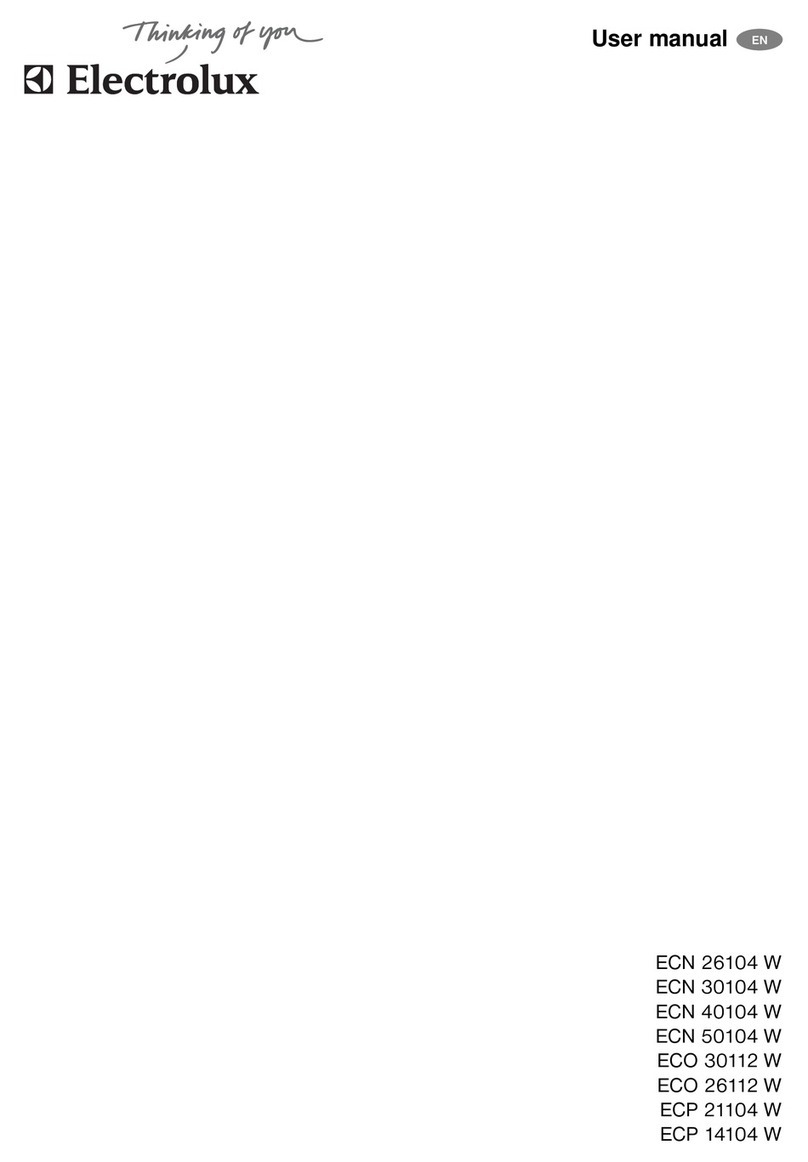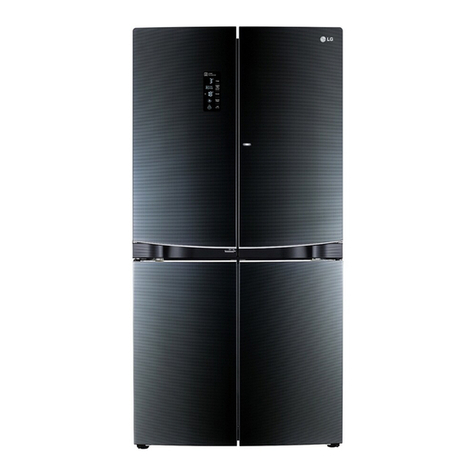Daewoo ERF-33 M Series User manual

•
ENGLISH 1
•
ESPAÑOL 7
•
FRANÇAIS 13
•
ITALIANO 19
•
NEDERLANDS 25
•
PORTUGUES 31
Models: ERF-33.M..., ERF-34.M..., ERF-36.M..., ERF-38.M...,
ERF-39.M..., ERF-40.M...., ERF-41.M..., ERF-300
GRIP HANDLE HIDDEN HANDLE

.
.

0121345167891
!"
0#786$74$5%
&' #1(&)8*+)1' +7,4-.1#8$-4+)/1%10122
3456789:;934<==89>?9@?AB98?989;AC;>DA;8EFG9HIJKKLM NOPQ
LPRKQSTJKNUKVJUVWXJVLPQKWYKYINZ PKNPKQIJKVLQWPXKT[LQJK
WPYWRJKQIJKLTT[WLP\J]
^_>?98``a>8EbA9b:EF8>E?989?c 8aa98c:@EF9:C
>?:d@F8EA9;AC;>DA;8EF9e3<==8fg989E8F@;8a9D8?9h>F_
_>D_9AEi>;:EcAEF8a9b:c `8F>d>a>Fjg9d@F9>F9>?98a?:
b:c d@?F>daAG9k _AE9F;8E?`:;F>ED98EB9>E?F8aa>ED9F_A
8``a>8EbAg9b8;A9?_:@aB9dA9F8lAE9F:9AE?@;A9F_8F9E:9`8;F?9:C
F_A9;AC;>DA;8F>ED9b>;b@>F98;A9B8c8DABG
m$n74.$7+-15o474-.1818n13$1646$518)914.-4$1871+5$
+-1$p$14-q7pr1sn1+1)$+t14519$$$9u1+v8491+-p1-+t$91n)+,$5
87168$-4+)1587$518n14.-448-1+-91+4713$1788, 14-1w343
3$1+66)4+-$14515+-94-.1n8715$v$7+)1,4-$5r
0 s-1879$7181+v84913$17$+48-18n1+1n)+,,+*)$1.+5x+47
,4y7$14n1+1)$+t14-13$17$n74.$7+4-.14741875u13$
54z$18n13$1788, 14-1w34313$1+66)4+-$1,+p1*$154$9
9$6$-9518-13$1+,8-18n17$n74.$7+-15$9r123$1788,
,51*$1{,
|
4-154z$1n871$v$7p1}.18n1m~+17$n74.$7+-
4-549$13$1+66)4+-$r123$1+,8-18n17$n74.$7+-14-1p87
6+74)+71+66)4+-$1451538w-18-13$149$-4n4+48-16)+$
4-549$13$1+66)4+-$r
0 $v$715+7161+-1+66)4+-$1538w4-.1+-p154.-518n
9+,+.$r1sn14-198*u18-5)1p8719$+)$7r
0 $$61v$-4)+48-186$-4-.514-13$1+66)4+-$1$-)857$187
4-13$1*4)x4-1577$u1)$+718n18*5748-r
0 81-815$1, $3+-4+)19$v4$5187183$71,$+-518
+$)$7+$13$19$n7854-.1678$55u183$713+-1385$
7$8,,$-9$91*p13$1,+-n+7$7r
0 81-819+,+.$13$17$n74.$7+-1474r
0 81-815$1$)$74+)1+66)4+-$514-549$13$1n8891587+.$
8,6+7,$-518n13$1+66)4+-$u15$)$5513$p1+7$18n1+1p6$
7$8,,$-9$91*p13$1,+-n+7$7r
1
:9E:F9`a@D9?AiA;8a98``a>8EbA?9>EF:9F_A9?8c A9?:blAF?G
0 234518)91+5$18v$73$+4-.1+-913$1745t18n1n47$r1
AA`9F_A9`:hA;9`a@D98h8j9C;:c9F_A9;A8;9:C9F_A9C;>BDA99C;AAA;G
0 19+,+.$9168w$716).1,+p1+5$1n47$19$1818v$73$+4-.r
:9E:F9B>;AbFaj9?`;8j9h8FA;9>E?>BA9:;9:@F?>BA9F_A9C;>BDA9
C;AAA;G
0 23$7$1451+1745t18n1n47$1871$)$741538tr
:9E:F9?`;8j9h8FA;9>E?>BA9:;9:@F?>BA9F_A9C;>BDA99C;AAA;G
0 23$7$1451+1745t18n1$y6)8548-1871n47$r
:9E:F9dAEB9F_A9`:hA;9b:;B9AbA??>iAaj9:;9`a8bA9_A8ij98;F>baA?
:E9>FG
0 234518-54$51+1n47$13+z+79r1sn13$168w$7187914519+,+.$9u
3+v$1417$6)+$914,,$94+$)p1*p13$1, +-n+7$7u14515$7v4$
+.$-1871+154,4)+7)p1o+)4n4$916$758-r
:9E:F9>E?A;F9F_A9`:hA;9`a@D9h>F_9hAF9_8EB?G
0 81,+p17$$4v$1+-1$)$741538tr
:9E:F9`@F989b:EF8>EA;9C>aaAB9h>F_9h8FA;9:E9F:`9:C9F_A
8``a>8EbAG
0 sn13$1w+$71564))518-181+-p1$)$74+)16+75u141, +p1)$+9181n47$
871$)$741538tr
:9E:F9>E?F8aa9F_A9C;>BDA99C;AAA;9>E989B8c `9`a8bAg9h_A;A9>F
b:@aB9dA9?`a8?_AB9h>F_9h8FA;G
0 s-877$14-5)+48-18n13$1$)$74+)16+751,+p1+5$1+-
$)$741538t1871n47$r
:9E:F9?F:;A9i:a8F>aA98EB9Ca8cc8daA9?@d?F8EbA?9>E9F_A
;AC;>DA;8F:;G
0 23$1587+.$18n1*$-z$-$u134--$7u1+)838)u1$3$7u1#1.+5187
83$715315*5+-$51,+p1+5$1+-1$y6)8548-r
:9E:F9B>?8??AcdaAg9;A`8>;9:;98aFA;9F_A98``a>8EbAG9
0 s1,+p1+5$1n47$1871+*-87,+)186$7+48-5u1w3431,+p1)$+918
4-q7pr
@aa9F_A9`:hA;9`a@D9:@F9:C9F_A9?:blAF9dAC:;A9;A`a8b>ED9F_A
>EFA;>:;9a>D_F9>E9F_A9;AC;>DA;8F:;G
0 3$7w45$u13$7$1451+1745t18n1$)$741538tr
A9?@;A9F:9A8;F_9F_A98``a>8EbAG
0 3$7w45$u141,+p1+5$1,+$74+)19+,+.$1+-91$)$741538tr1
C9j:@9h>?_9F:9B>?`:?A9:C9F_A9C;>BDA99C;AAA;g9F_;:h9>F98h8j
8CFA;9;Ac:i>ED9F_A9B::;9:;9>F?9?A8a?G
0 s-13451w+pu141451-8168554*)$1n871+134)91817$,+4-17+66$9
4-549$14r
:9E:F9?F:;A9F::9c @b_9C::B9>E9F_A98``a>8EbAG
' 3$-1p8186$-13$19887u1+-14$,1,+p1n+))181+-91+5$
6$758-+)14-q7p1871,+$74+)19+,+.$r
:9E:F9`@F9d:FFaA?9:;98Ej9l>EB9:C9Da8??9>E9F_A9C;AAA;G
23$18-+4-$71,+p1*7$+t1+-91+5$16$758-+)14-q7pr
C9F_A9h8aa9?:blAF9>?9a::?Ag9B:9E:F9>E?A;F9F_A9`:hA;9`a@DG
0 s1,+p1+5$1$)$741538t1871n47$r
:9E:F9B>?b:EEAbF9F_A9`:hA;9b:;B9dj9`@aa>ED9:E9>FG
0 81,+p19458--$1+1w47$1+-91+5$1+153871474r
:9E:F9?F:;A98;F>baA9:E9F:`9:C9F_A98``a>8EbAG
k 399^93^
281+v8491+-p1745t18n16$758-+)14-q7pu1,+$74+)19+,+.$18714-877$15$18n13$1+66)4+-$u1*$157$1818*5$7v$13$1n8))8w4-.15+n$p
67$+48-5r1(n$717$+94-.13$5$18w-$7514-5748-5u16)$+5$1t$$613$,14-1+15+n$16)+$1n8717$n$7$-$/r1m$,$,*$71813+-913$,18v$718
+-p15*5$o$-18w-$7r
s-94+$513+1+19+-.$718n18n19$+318715$7485
4-q7p1$y455
s-94+$513+1+1745t18n16$758-+)14-q7p187
,+$74+)19+,+.$1$y455r
¡¢£¤
¥¦§¨¡©
ª«¥¨¥¬
¡ª§¨¦¥
ª«¥¨¥¬
33 3 ^9 3® ^
EDa>?_
«¯°±²³
«¯´µµ
¶ ·¸¹º»¼½¾¿ÀÁ»¼½¾ÂÃÁº»Â¸Ã»ÃÄŹ½¾ÄÆÃÄ»ÇÈ»Àº¹Äɻ¸ûÊË
ÌÍÍλ½ÃϽ¹ÉýÎÄ»ÎÄ¿»Â¸Ã»ÁÈÁо¼ÃÄÂÎÄûÇоѹÄÉ»ÎÉÃÄÂÒ
¶» Ó Ó Ó Ó ÓÔ½¾¼Ã½Â¹ÃºÕ
Ö ×Ô»ØÖ Ù¾ÄÃ»× Ã¼Ðù¾Ä»Ô¾ÂÃĹÎÐÚ»Õ»Í
ÛÜ Ô»ØÛоÇÎÐ»Ü Î½Æ¹ÄɻԾÂÃĹÎÐڻջݾÑúÂ

English
• When you open or close the door, the articles may fall and
cause personal injury or material damage.
Do not store pharmaceutical products, scientific material or
other temperature-sensitive products in the refrigerator.
• Products that require strict temperature controls must not be
stored in the refrigerator.
Do not let a child hang from the door.
Do not touch any containers and food in the freezer with
wet hands.
• It may cause frostbite.
Remove any foreign matter from the power plug pins.
• Otherwise, there is a risk of fire.
Do not insert your hand into the bottom area of appliance.
• Any sharp edges may cause personal injury.
After unplugging the appliance, wait for at least five
minutes before plugging it again to the wall socket.
• Abnormal operation of the freezer may cause material
damage.
If the appliance is not be used for a long period of time,
pull out the power plug.
• Any deterioration in the insulation may cause fire.
Do not let children touch or play with the control panel on
the front of the appliance.
• Do not allow children to play with this appliance.
• Do not stand or lean on the base panel, pull-out parts, door
and so on.
• Repairs and maintenance of the appliance should only be
performed by a qualified technician. Incorrect repairs by an
unqualified person are a potential source of danger that may
have critical consequences for the user of the appliance.
• Never put ice cubes or ice lollies straight from the freezer into
your mouth. (The low temperature may cause “cold burns”.)
The refrigerant used in fridge / freezers and the gases in the
insulation material require special disposal procedures. Ensure
that none of the pipes on the back of the appliance are damaged
prior to disposal.
DISPOSAL
INSTALLING THE FRIDGE / FREEZER
1. Allow an adequate space and install the fridge / freezer on a
firm, level floor.
• If the appliance is not level, there may be unusual noises
and poor cooling.
2. Clean the fridge / Freezer
• Wipe and clean the inside and outside of appliance with a
damp cloth.
3. Plug the fridge / freezer into a wall socket used exclusively by
this appliance.
• This appliance must be properly earthed.
4. Place the food in the fridge / freezer.
• It is recommended that you wait for the appliance to cool
for 3~4 hours before storing food in it.
5. Keep 60 mm of space between the refrigerator and the back
wall.
• Insufficient space causes the noise of vibration, weakening
of refrigerating power and the waste of electricity
6. The electrical plug must be accessible without moving the set.
7. For ambient temperature below 10ºC, the perfect
performance of our refrigerator can not be achieved.
Use of an earthed socket exclusively
for the appliance:
• If you are using a socket with an earthed terminal, you do not
require a separate earthed connection.
Use of a non-earthed socket:
• Connect the “earthed wire” to the steel plate and bury it at
depth of at least 25cm in the ground.
LEVELING
If the front of the appliance is slightly higher than the rear, the
door can be opened and closed more easily.
1. The appliance tilts down to the
left.
Turn the left adjusting leg in the
direction of the arrow until the
appliance is level.
2. The appliance tilts down to the
right.
Turn the right adjusting leg in the
direction of the arrow until the
appliance is level.
PREPARING THE FRIDGE / FREEZER
To prepare your appliance for use and check that it is running
correctly, take the following steps.
1. Install removed all shelves and compartments during transport
in the correct positions.
2. Clean the fridge/freezer and accessories to remove any dust
that accumulated during packing and shipping.
3. The interior light should be turned on when the refrigerator
door’s opened.
4. Set the temperature control to the coldest temperature and let
the refrigerator operate for one hour. The freezer should get
slightly chilled and the motor should run smoothly with a soft
hum and no noise. Your fridge / freezer is operated by a
compressor which switches “on and off” to maintain the
internal temperature. When the compressor is new, it requires
running in for a period of up to five months. During this
period, it may be slightly noisy.This is quite normal and does
not represent a fault.
5. Store food once the temperature in the refrigerator is
sufficiently low. It takes a few hours after starting the
refrigerator to reach the proper temperature.
If the appliance does not operate correctly, check the
electricity supply. If the problem persists, contact your dealer.
2
WARNING
CAUTION

English
3
This product has been designed, constructed and marketed in
accordance with EU directives 2006/95, 2004/108 and
96/57.
Please read this manual carefully to ensure maximum satisfaction
from your appliance. Keep the manual in a safe place for future
reference. For drawings referenced in the text below, see flap at
back of the manual.
ABOUT THIS PRODUCT
■
This product is designed for domestic household use only.
■
Use the 4-star freezer compartment
- to freeze fresh and cooked foods,
- to store deep-frozen and frozen products,
- to make ice-cubes.
■
Use the refrigerator compartment
- to store fresh foods,
- to cool drinks.
■
The freezer and refrigerator compartments defrost
automatically.
■
Owing to cool air circulation (multi-airflow system) an even
temperature is maintained on every shelf of the refrigerator
compartment. The low temperature compartment is specially
designed to extend nutritional value and original freshness of
the food.
BEFORE CONNECTING TO THE MAINS
1. Wait 2 hours after delivery before you connect the appliance
to the power supply, in order to ensure trouble-free
operation.
2. In the UK only. Electrical connections:
- Check that the voltage on the rating plate (8) corresponds
to the voltage in your home.
- The wires of the mains lead fitted to this appliance are
coloured in accordance with the following code:
GREEN and YELLOW = EARTH
(GREEN or GREEN and YELLOW)
BLUE = NEUTRAL (BLACK)
BROWN = LIVE (RED)
As the colours of the wires in the mains
lead fitted to this appliance may not correspond with the
coloured markings identifying the terminals in the plug,
proceed as follows:
- The wire which is coloured GREEN and YELLOW must
be connected to the terminal in the plug which is marked
with the letter “E” or by the earth symbol ( ) or
coloured GREEN or GREEN and YELLOW.
- The wire which is coloured BLUE must be connected to
the terminal which is marked with the letter “N” or
coloured BLACK.
- The wire which is coloured BROWN must be connected
to the terminal which is marked with the letter “L” or
coloured RED.
If the terminals in the plug are unmarked or you are in any
doubt as to the correct connections, consult a qualified
electrician.
3. In the UK only. Moulded plugs:
- Applicable only if moulded plug is fitted.
- Should it be necessary to remove a moulded on plug from
the mains cable, it should be cut off and replaced with a
suitable replacement.
- The moulded plug cannot be used for any other
appliance, therefore remove the fuse and dispose
immediately and safely to prevent anyone, especially
children, from plugging it into a wall socket, which will
create a safety hazard.
DESCRIPTION OF YOUR REFRIGERATOR
See flap at the back of the manual.
1. Shelves (The material of shelf be changed by
model.)
2. Cover vegetable case (The material be
changed by model).
3. Interior light for refrigerator compartment.
4. Multi air flow duct.
5. Refrigerator & freezer temperature control
knob.
6. Low temperature compartment (Only in
some models).
7. Vegetable case: 1 box type or 2 boxes type. In
case of 1 box type must be deleted (15).
8. Rating plate. It´s attached in the refrigerator
compartment on the left-hand side next to
the vegetable case.( with serial number).
9. Case for storing & freezing (Only in
10. Case for storing & freezing.
11. Butter pocket.
12. Egg pocket.
13. Egg tray.
14. Bottle pocket.
15. R door pocket.
16. Adjustable foot.
17. Cap screw hole.
some models).

4
- Should the mains lead ever require a replacement, it is
essential that this operation be carried out by a qualified
electrician and should only be replaced with a flexible
cord obtained from the manufacturer.
- After replacement of a fuse in the plug, the fuse cover
must be refitted. If the fuse cover is lost a replacement
cover must be obtained. The colour of the correct
replacement fuse cover is that of the coloured insert in the
base of the plug or the colour that is embossed in words
in the base of the plug recess or elsewhere on the plug.
Always state this colour when ordering a replacement fuse
cover.
- Only 13 amp. replacement fuses which are ASTA
approved to BS 1362 should be fitted.
4. Check the rating plate (8) for voltage information.
5. The socket should be easily accessible and not directly
behind the appliance.
6. Electrical connections must be made in accordance with
local regulations. The appliance must be earthed as described
by law (connected through a properly earthed plug and
socket). The manufacturer rejects all liability for injury to
persons and animals or damage to property resulting from
failure to comply with this requirement.
7. A 10A fuse or one of a higher value must be used in the
socket circuit.
8. If the appliance plug and the wall socket are incompatible,
the socket must be replaced by a qualified electrician.
9. If the supply cord is damaged, it must be replaced by the
manufacturer or his service agent or a similarly qualified
person in order to avoid hazard.
10.Do not use extension leads or multiple adapters, etc.
11.In some countries a plug has to be fitted. Make sure that the
installation and electrical connections are performed by a
qualified technician in compliance with the manufacturer’s
instructions and current local safety regulations. The wires in
the mains lead are coloured in accordance with the following
code:
- green/yellow = earth
- blue = neutral
- brown = live.
DISCONNECTION
Note: does not apply in the UK.
Electrical disconnection: remove the plug from the mains, or (if
applicable) disconnect the two-pole circuit breaker upstream
from the socket.
PROTECTING THE ENVIRONMENT
- The packaging may be completely recycled, as confirmed by
the recycling symbol; follow local disposal regulations.
- The appliance is manufactured from reusable materials.
- When you decide to scrap this product, please check the
cable to be disconnected from the mains. Then cut off the
cable and dispose of the product according to local waste
disposal laws.
- This product is free of CFC’s (cooling circuit contains R134a
or R-600a). Check the compressor label on the rear of the
appliance or the rating label inside the fridge to see which
refrigerant is used for your refrigerator.
English
Check for damages and correct
closing of the doors. Not in the vicinity of a heat source.
Keep room dry and well ventilated. Do not obstruct the top of refrigerator
in order to keep enough ventilation.
Clean interior with a damp cloth. Best room temperature range -
+16°C to +32°C.
IMPORTANT
1. Although this product was carefully checked before
packing, please check the product:
- for damage;
- for correct closing of the doors.
Complaints must be reported to your retailer within 24
hours of delivery.
2. Installation instructions (7 drawings below).
3. Keep potentially hazardous packing materials (plastic
bags, etc.) out of reach of children to prevent the risk
of trapping
and suffocation.
Wait 2 hours before connecting to the
mains.

5
HOW TO USE THE REFRIGERATORCOMPARTMENT
Connet the lead to the mains. ( At least wait 2 hours after
delivery: refer to section ”Before connecting to the mains)
Food can be stored after 3 to 4 hours cooling.
- the interior light switches on when the door is opened;
- the compressor operates and starts cooling;
The suitable storage temperature for fresh food is provided in
the "MID" position at an ambient temperature of 16 ~ 32ºC.
REFRIGERATOR AND FREEZER TEMPERATURE
CONTROL KNOB (5) SEE FLAP AT BACK OF MANUAL.
(Knob is located inside the refrigerator compartment.)
"LOW": warmer than position "MID"
“COOLING OFF”: The cooling system stops working (only
the lamp is working).
Note: When you set ”refrigerator and freezer temperature control
knob”(5) LOW, MID, and HIGH then the temperature of the
refrigerator and freezer are automatically adjusted.
NOTES ON FREEZING AND STORAGE
1. Follow storage times indicated by the frozen food
manufacturer. Make sure that the packaging is undamaged.
2. Save energy: minimize opening of the door by storing
identical food items together.
3. Items suitable for freezing: meat, poultry, fresh fish,
vegetables, fruits, dairy products, bread, baked goods, pre-
cooked meals.
4. Items not suitable for freezing: lettuces, radishes, grapes,
whole apples and pears, fatty meats.
5. When you freeze food yourself, pack it in appropriate
quantities. In order to freeze food right through do not
exceed the following quantities to best preserve the quality:
- fruit and vegetables: up to 1 kg,
- meat: up to 2.5 kg.
6. Blanch vegetables after washing and cutting them. (2-3
minutes in boiling water; then quickly cool them down in
cold water. When you use a steamer or microwave oven,
follow the operating instructions).
7. Keep packs dry in order to avoid them freezing together.
8. Freeze fresh food separately from already frozen foods.
9. Do not salt or season fresh food or blanched vegetables
before freezing. Other foods may be lightly salted or
seasoned. The intensity of flavour of some spices can change.
10.Use materials or containers specially suitable for freezing in
order to avoid loss of quality during defrost.
11.Write contents and date of freezing on the packs. Do not
exceed the storage time indicated in order to preserve quality.
12.Do not freeze bottles or cans with carbonated drinks as they
might burst.
13.Take out as much food as is immediately required for
thawing. Prepare it as soon as possible after thawing.
WHEN PURCHASING FROZEN FOOD
1. Make sure that the packaging is undamaged (damage may
have caused the food to deteriorate). Bulging packs or packs
which are marked with liquid stains could have been
improperly stored and may have been partially thawed.
2. Leave frozen food purchases until last and transport the
items in insulated bags.
3. Place the items in the freezer as soon as possible.
4. Do not refreeze partially thawed food. Consume it within 24
hours.
5. Observe the date of consumption and storage information.
CLEANING
1. Always disconnect the appliance from the mains supply.
2. Do not use abrasives. Periodically clean with a sponge
dampened in lukewarm water. A neutral pH detergent may
be used. Rinse and dry with a soft cloth.
3. Wipe the outside with a soft cloth dampened in water.
4. Periodically clean the front grille and the radiator at the back
with a vacuum cleaner or a brush.
English
GENERAL RECOMMENDATIONS
Keep air vents open. No glass bottles in the freezer
compartments. The bottles might
burst.
Ice cubes and ice lollies straight out
of the freezer are too cold for
consuming.
They may cause ‘cold’ burns.
Do not allow children to play or hide
in the refrigerator to prevent the risk
of trapping and suffocation.
Always unplug before cleaning and
servicing. Do not storage too much food in the front
area of the shelves.
"HIGH": colder than position "MID"
"MID": normal storing temperature
Avoid food overload inside refrigerator.
Do not block the air ducts with food.
This would affect to the performance
of the refrigerator.
If the supply cord is damaged, it
must be replaced by the
manufacturer or its service agent or
a similarly qualified person in order
to avoid a hazard.

6
PROLONGED DISUSE
1. Empty the refrigerator and freezer compartments.
2. Unplug the appliance from the mains.
3. Clean and dry both compartments.
4. Leave the doors open to prevent the formation of unpleasant
odours.
AFTER SALES SERVICE
Before contacting our After Sales Service Department:
1. Try to remedy the problem (please read section “trouble
shooting guide”).
2. Restart the appliance to check whether the fault repeats. If
the malfunction persists, switch off the appliance and try
again after an hour.
3. If the malfunction still persists, then contact our Customer
Service, specifying:
- the nature of the problem,
- the appliance model number,
- the service number (please see the rating plate 8),
- your full address, telephone number and area code.
Note: door opening direction changes carried out by our Customer
Service are not covered by the terms of guarantee.
TROUBLESHOOTING GUIDE
1. The appliance does not work. Check:
- power failure,
- properly inserted plug,
- (if applicable) connection of the two-pole circuit breaker,
- damage to the mains lead,
- correct setting of the temperature controls (5).
2. The temperature inside the compartments is not low
enough. Check for:
- closure of the doors,
- installation near a heat source,
- correct setting of the refrigerator/freezer control knob (5),
- inhibited air circulation.
3. The refrigerator compartment temperature is too low.
Check for:
- correct setting of the temperature controls (5).
4. The internal light does not work. Refer to point 1 and then:
- unplug the appliance from the mains,
- check the bulb and replace if necessary (max.15W).
- to change the lamp first remove the window lamp by
pushing lower part upward and pulling forward.
- take out the lamp and replace it for a new one.
- finally set again window lamp on its place.
English
Disposal of Used Electrical & Electronic Equipment
The meaning of the symbol on the product, its accessory or packaging indicates that this
product shall not be treated as household waste. Please, dispose of this equipment at your
applicable collection point for the recycling of electrical & electronic equipments waste. In
the European Union and Other European countries which there are separate collection
systems for used electrical and electronic product. By ensuring the correct disposal of this
product, you will help prevent potentially hazardous to the environment and to human
health, which could otherwise be caused by unsuitable waste handling of this product. The
recycling of materials will help conserve natural resources. Please do not therefore dispose
of your old electrical and electronic equipment with your household waste. For more
detailed information about recycling of this product, please contact your local city office,
your household waste disposal service or the shop where you purchased the product.
APPLIANCE PACKAGING INFORMATION
All material are environmentally sound! They can be dumped or
burned at an incinerating plant without danger!
About the materials: The plastics can be recycled and are
identified as follows:
■
PE : for polyethylene, e.g. the outer covering and the bags in
the interior.
■
PS : for polystyrene foam, e.g. the pads, which are all free of
chlorofluorocarbon.
The carton parts are made from recycled paper and should be
disposed of at a waste-paper recycling collection location.
DISPOSAL OF OLD APPLIANCES
For environmental reasons, refrigeration appliances must be
disposed of properly. This applies to your old appliance, and -at
the end of its service life- for your new appliance as well.
Warning! Before disposing of old appliances make them
inoperable. Remove plug from mains, server the power cable,
remove or destroy any snap or latch closures. This eliminates the
danger that playing children lock themselves into the appliance
(danger of suffocation!) or place themselves into other life-
endangering situations.
Disposal:
• The appliance may not be disposed of with domestic waste or
bulky refuse.
• The refrigerant circuit, especially the heat exchanger at back of
the appliance, may not be damaged.
• Information concerning collection schedules or locations can
be obtained from the local disposal authorities or town hall.
The lamp of the refrigerator can be switched off even though the
doors are not completely closed.
Note: The edge of the refrigerator door and the front side of the
refrigerator cabinet may be hot. This is normal and intended to
prevent the formation of condensation.
Gurgling noises etc. inside the refrigerating circuit are normal.
English
NOTICE
This appliance is not intended for use by persons (including
children) with reduced physical, sensory or mental capabilities,
or lack of experience and knowledge, unless they have been given
supervision or instruciton concerning use of the appliance by a
person responsible for their safety.
-o0o-

GUARANTEE CONDITIONS
We DAEWOO, undertake that if within 12 months from the date of purchase, this
DAEWOO appliance or any part there of is proved to be defective by reasons only of
faulty workmanship or materials, we will, at our option repair or replace the same
FREE OF ANY CHARGE of labour, materials or carriage on conditions that:
The appliance has been correctly installed
and used only on the electricity supply
stated on the rating plate.
The appliance has been used for normal
domestic purposes only and in accordance
with the manufacturers operating and
maintenance instructions.
The appliance has not been serviced,
maintained, repaired, taken apart or tampered
with, by any person NOT authorized by
DAEWOO.
All service work under this guarantee must
be undertaken by a DAEWOO service
representative or authorized agent.
Any appliance or defective part replaced
shall become the property of DAEWOO.
This guarantee is in addition to your
statutory and other legal rights.
EXCLUSIONS:
This guarantee does not cover:
Damage or calls resulting from
transportation, improper use or neglect, the
replacement of any light bulbs or removable
parts of glass or plastic.
The light bulb is not covered by this
warranty.
Cost incurred for calls to put right an
appliance which is improperly installed or
calls made outside the United Kingdom.
Appliance found to be in use with in a
commercial environment, plus those which
are subject to rental agreements.
Products of DAEWOO manufacture which
are not marketed by DAEWOO Electronics
Sales UK Ltd.
EEC Countries. The standard guarantee is
applicable but subject to the owners
responsibility and cost to ensure the
appliance meets the standards set by the
country of which the product is taken. The
DAEWOO Electronics Sales office in the
country, will be pleased to advise further.
Should you require after sales service for this product, please contact DAEWOO Electronics Sales,
Customer Services department on 01189 252530, or the dealer you purchased the item from.
G

.
.

7
234536758749474647758339 85347647499347657
!"#$%& '(% )%'*$%!+%!
$,
- .6876/.47476574745376874.70.3474.41.8741387347
/32533536/7.3
4 )5$5 )6 $)%%$#!$'%!'$ $'
'#%$!! '(% )5 ),
234177574./.4758.9768747647468734347887347
/32533536/7.3
#$%&#%9%! $'!"%%! $'%+:)%,
2348574/.746.9.;74575.474/32533536/7.3
<$%&#%9%! =#'6 $,
>35746343;.478577.9 76874745.;7474.9 768.5?64645335.
3;0783417.343;74
234678747476574764.4839.474.9 768.5?645364.49.63
930..
<$%&'!"%%! $'%+:)%,
234533B7466/C64751768745364./.47659.474/3253
+!'$%%5 * )% )) '5# )'
:)%'#$%&#%$!%'! $! $'%+:)%,
23468.7474/3253476464/.4C97346476464/.476474B7
7847817834.4.15..474./.
D )) ''5# )':)%'#!$#%9%!
$$'%+':)%',
234/.748.65.473874346.9 .;7476474687347
/3253
+!%$( $!* )':)%+'#%#!' )&E!$
!E!%)%'!') '5%#$%&#%9%! =#'6 ,
234793687F471.74645.9 ;7466/C645391367687474/32534
<$%&#%9%! $! "! 5 ) %%)!
#$%&' %$A',
G7536758747476574.6874745.9;.4.4;39 ;.4687347
7/7.3
H %%%%'+$'!"%%! $'%+:)%,
I7/C77474B7474/325341367474.453678?64.487.
.131..
H )%%#$%&' %$A'5)%'%%%%'+
$'!"%%! $'%+:)%,
J47.4.48.474/32533536/7.3F4B87419734.4178.4K4.
/39 .474577479853474.49 9.
H')5$9)%@E!! A#!$E!$%)%#$
)%%,
234/.7479..34.9 7683476474/3253
D'#'(E!++L (M))%'#%)!%$#!%)$ $
!+%' '"&''$A'5)%',
234683N5.4;387.46466/C643834813474751768747458.47647
536/7.3
D%# )#$%&%5#%'*' %' '"&'',
J43;77.4B74.4839.47585.474.41.746347847;.97687
68...F4634678747647.466/C647657
<$%&' %! $! $'%+:)%,
O1.P3
IGQORSO2TUIJ434>ROTIVTUW2OJ4GO4JOXVRUGIG
<%9)%' '"''#%' '*$A'5)%''&5 !'%%)$'))%$5:')'+L%'$'+!% )$
55 )'#%! '$'+!%$$E!'"% )!6 ,Y! 9ZE!*&$')5 !$!'!% 9 E!
+!%$ ! !+%'+!%#%' ') '!)%$!9[,\!%$ )%+%5 !#'('!'!%'#')%%',
]"%5$%'+$'!"%%' '+%9'
$ )
]"%5$%'+$' '"&''
#%' '$A'5)%',
^_`abcadefg hbaegiefjd
^klmnompqr^
hnmq^sqrtp
O4/32534.4347/7.6874Ruvv.434R01w.4T3687
.478B78.4
D')#%$!) ,
<%#$$'x
yz <Y<) $% )5 )$# )[x
O8747758339 785345368767417B7P.45.68.7
747/7.6874743;8.634{Ruvv.|F464/.46.8.
B7F4.6B7474.8.9768745391.8;745364749 73
.9 ;7687F48.9 ;6478.4539;8;74O887974.
175.5536741..4634.P.466/C64539136768747
55834747/7.5?64.6874748.613874K4.
68..5?6474/353
%"%+% )+'%'$' $!)'#$%&
#%9%+ 6 !'' %' ' 9'),
('%9E!&E!$+)9)'!=#'6 $%)
5'#'('"! )'$+ 6 *%$!% )
! '5!)'()6 E!' ! )%
"%+%&",
#%9)%"%5 6 $! 5Z$%*+'
"5( '$E!'#%$!Z! '#
%!)$%"%+%6 $(%"%+%&" !
()6 $)5A#%#$ )$$$
%"%+% )E!')!)Z,]()6 $(%@5$%}
5~#%$+$%"%+% )\E!'*
!)Z$ )%%$"%+%&",] )$$$
%"%+% )E!!)Z'!5$'#&"$"%+%"
'5!')% #$$ )"6 ')!$
)%%$:'),
$ ! +L )%$5:')E!#%Z
$A$,) +! $!$ '!)'!$')%(!$%,
<%!%(')%!%'%M'$9 )6 $
"%+%&",
!)$'#')9'5@ '!E!%)%5 $
$%6 $#%'$$' +6 E! '
'%5 $$'#%"(% ),
<%!%$A%%!)$%"%+%6 ,
4)'5#%#%"%+%&" +$%)#$
5# )':)%')% '%5 $$#%
"(% ),
^ompqrtp
^klmnompqr^
U2 W R- I TUW 2 4JW RO4O4RORUX ORI2 SO
ng
ng
$
Si lo hace, podría provocar un incendio. Si el cable de alimentación
está dañado, debe ser sustituído por el fabricante o una persona
del servicio posventa.
•

8
No tire del cable de alimentación para desenchufarlo.
• Podría desconectar algún hilo del cableado y provocar un
cortocircuito.
No coloque ningún objeto encima del frigorífico.
• Podrían caerse al abrir o cerrar la puerta, ocasionando lesiones físicas
o daños materiales.
No guarde en el frigorífico productos farmacéuticos, sustancias de
uso científico ni productos sensibles a los cambios de temperatura.
• Asimismo, no guarde en el frigorífico productos que requieran un
control de temperaturas estricto.
No deje que los niños se cuelguen de la puerta.
No toque ningún recipiente o alimento que se encuentre en el
interior del frigorífico con las manos mojadas.
• Corre el riesgo de sufrir “quemaduras” a causa del frío.
Retire cualquier objeto extraño de las patillas del enchufe.
• De lo contrario, podría producirse un incendio.
No introduzca la mano entre la base del frigorífico y el suelo.
• La base contiene bordes afilados que podrían ocasionar lesiones
físicas.
Una vez que haya desenchufado el frigorífico, espere al menos cinco
minutos antes de volver a enchufarlo en la toma.
• El uso incorrecto del congelador podría ocasionar daños materiales.
Si no va a utilizar el frigorífico durante un período de tiempo
prolongado, desconecte el cable de alimentación.
• Cualquier deterioro en el aislamiento puede ser causa de incendio.
Evite que los niños toquen o jueguen con el panel de controles que se
encuentra en la parte frontal del frigorífico.
• Evite que los niños jueguen con el frigorífico.
• No debe subirse ni apoyarse en el panel de la base, piezas extraíbles,
puertas, etc.
• Las reparaciones y el mantenimiento del frigorífico solo debe
realizarlas el personal técnico cualificado. La reparación incorrecta
por parte de una persona sin la cualificación necesaria puede dar
lugar a situaciones de peligro que podrían tener graves
consecuencias para el usuario.
• si saca cubitos de hielo o helados del congelador, deje transcurrir
algún tiempo antes de consumirlos(Podría sufrir “quemaduras”
debido a su baja temperatura.)
El refrigerante que utilizan los frigoríficos/congeladores y los gases
presentes en el material de aislamiento deben desecharse siguiendo
unos procedimientos específicos. Antes de desechar el frigorífico,
asegúrese de que ninguno de los conductos situados en la parte
posterior está dañado.
DISPOSICIÓN
INSTALACIÓN DEL FRIGORÍFICO / CONGELADOR
1. Busque un lugar apropiado e instale el frigorífico/congelador en un
suelo firme y nivelado.
• Si el frigorífico no queda bien nivelado, Podría producir ruidos
extraños y disminuir su capacidad de refrigeración.
2. Limpie el frigorífico/congelador.
• Utilice un paño húmedo para limpiar el interior y el exterior del
frigorífico.
3. Enchufe el frigorífico/congelador en una toma mural en la que no
haya conectado ningún otro aparato.
• El frigorífico debe disponer de la conexión a tierra apropiada.
4. Coloque los alimentos en el interior del frigorífico/congelador.
• Es recomendable que deje enfriar el frigorífico durante unas 2 ó 3
horas antes de guardar los alimentos.
5. Deje 60 mm de hueco entre el frigorífico y la pared trasera.
• Un espacio insuficiente causa ruido por vibración, debilita el
poder de refrigeración y desperdicia energía.
6. El enchufe eléctrico debe ser accesible sin mover el frigorífico.
7. Con temperatura ambiente inferior a 10ºC, no se logrará el perfecto
funcionamiento del frigorífico
Utilice una toma con conexión a tierra en la que no haya conectado
ningún otro aparato:
• Si esta utilizando una toma que dispone de un terminal de
conexión a tierra, no necesitará conexión a tierra adicional.
Uso de una toma sin conexión a tierra:
• Conecte el “cable de conexión a tierra” a la placa de cobre y
entierrelo a una profundidad mínima de 25 cm.
NIVELACIÓN
Si coloca la parte frontal del frigorífico a una altura un poco superior
a la de la parte posterior, podrá abrir y cerrar la puerta con mayor
facilidad.
1. El frigorífico esta inclinado hacia la
izquierda.
Gire el pie regulable izquierdo
siguiendo la dirección de la flecha
hasta haber logrado la nivelación
deseada.
2. El frigorífico esta inclinado hacia la
derecha.
Gire el pie regulable derecho
siguiendo la dirección de la flecha
hasta haber logrado la nivelación
deseada.
OPERACIONES PRELIMINARES
Para preparar el frigorífico para su uso y comprobar si funciona
correctamente, siga los pasos que se describen a continuación.
1. Coloque en su sitio todos los estantes y compartimentos que se
hayan extraído para transportar el frigorífico.
2. Limpie el frigorífico/congelador y los accesorios para retirar el
polvo que se haya acumulado durante el embalaje y el envío.
3. La luz deberá encenderse al abrir la puerta del frigorífico.
4. Seleccione la temperatura más alta en el control de temperatura y
deje el frigorífico en funcionamiento durante una hora. El
congelador deberá haberse enfriado ligeramente y el motor deberá
empezar a funcionar despacio, con un leve sonido, pero sin
producir ruido. El frigorífico/congelador funciona con un
compresor que lo apaga y lo enciende con el fin de regular la
temperatura interna. Si el compresor es nuevo, es necesario dejarlo
en funcionamiento durante un período de cinco meses. Durante
este período, podría producir cierto ruido. Este es un
comportamiento habitual y no implica que el frigorífico esté
defectuoso.
5. Espere a que la temperatura del refrigerador sea lo suficientemente
baja antes de guardar los alimentos. Deberán transcurrir algunas
horas antes de que el frigorífico alcance la temperatura apropiada.
Si el frigorífico no funciona correctamente, compruebe el
suministro eléctrico. Si el problema persiste, consulte al
distribuidor.
Español
ATENCION
ADVERTENCIA

9
Este producto ha sido diseñado, construido y comercializado
en conformidad con las Directivas 2006/95, 2004/108 y
96/57 de la UE.
Para obtener el máximo rendimiento de su aparato, debe leer
cuidadosamente este manual del usuario. Conserve este
manual en un lugar seguro para su posible consulta futura. Vea
la solapa al final del manual para los dibujos aludidos en el
texto expuesto abajo.
ANTES DE UTILIZAR EL APARATO
■Este producto está diseñado exclusivamente para uso
doméstico.
■Utilice el compartimento congelador de 4 estrellas para:
- congelar alimentos frescos y cocinados,
- hacer cubitos de hielo
- conservar alimentos ultracongelados y congelados.
■Utilice el compartimento refrigerador para:
- conservar alimentos frescos,
- enfriar bebidas.
■Los compartimentos de congelación y refrigeración se
descongelan automáticamente.
■Gracias a la circulación de aire frío (sistema de flujo de aire
múltiple), se mantiene una temperatura uniforme en todos
los estantes del compartimento de refrigeración. El
compartimento de baja temperatura está especialmente
diseñado para ampliar el valor alimenticio y la frescura
original del alimento.
ANTES DE CONECTAR EL APARATO A LA RED
1. Después de colocar el aparato en su lugar, espere dos horas
antes de conectar el mismo a la red eléctrica para asegurar
su funcionamiento correcto.
2. Controlar el voltaje indicado en la etiqueta de datos(8).
3. La toma debe ser fácilmente accesible y no directamente
detrás del aparato.
4. Las conexiones eléctricas deben realizarse de acuerdo con
las normativas locales. El aparato debe estar conectado a
tierra según prescrito por la ley (con enchufe y toma
conectados a tierra). El fabricante no asume ninguna
responsabilidad por daños causados a personas o animales
o daños materiales resultantes del incumplimiento de este
requisito.
5. La toma debe estar protegida con un fusible de 10A o
superior.
6. Si el enchufe del aparato y la toma son incompatibles, la
toma debe ser sustituida por un electricista cualificado.
7. Si el cable eléctrico está dañado, éste debe ser sustituido
por el fabricante, su servicio de asistencia técnica o por una
persona similar cualificada con el fin de evitar riesgos.
8. No utilice cables prolongadores, adaptadores múltiples, etc.
9. En ciertos países es necesario cambiar el enchufe. Asegúrese
de que la instalación y las conexiones eléctricas sean
llevadas a cabo por un técnico cualificado y con arreglo a
las instrucciones del fabricante y las normativas de
seguridad vigentes en el país. Los colores de los hilos del
cable eléctrico tienen el significado siguiente:
- verde/amarillo = tierra
- azul = neutro
- marrón = corriente.
DESCONEXION
Desconectar el aparato sacando el enchufe de la toma eléctrica
o, (en su caso) poniendo el disyuntor bipolar hacia arriba.
Español
DESCRIPCION DEL FRIGORIFICO
Vea la solapa al final del manual
1. Estantería (El material de la estantería
depende del modelo).
2. Estante para tapar el cajón de verduras (El
material depende del modelo)
3. Luz interior para el compartimento del
refrigerador.
4. Conducto de flujo de aire múltiple.
5. Dial de control de la temperatura del
frigorífico y del congelador.
6. Compartimento de la baja temperatura (solo
en algunos modelos)
7. Cajón para verduras con dos cajones o un
cajón. En caso de un cajón, el punto 15 no es
aplicable.
8. Etiqueta de datos. Está fijada en el
compartimento del frigorífico, a la izquierda,
junto a los cajones para verduras. (con el
numero de serie)
9. Compartimento para guardar y congelar.
10. Compartimento para guardar y congelar.
11. Recipiente para mantequilla.
12. Recipiente extraible (para la huevera).
13. Huevera.
14. Botellero.
15. Recipiente extraible para la puerta.
16. Patas de altura regulable.
17. Embellecedor de los agujeros de la bisagra.
(solo en algunos modelos).

10
IMPORTANTE
1. Aunque este producto ha sido controlado cuidadosamente antes de ser embalado, por favor asegúrese de que:
- no presente daños,
- las puertas cierren correctamente.
Si detecta cualquier daño, debe comunicarlo a su distribuidor en un plazo de 24 horas después de la entrega.
2. Instrucciones de instalación (7 dibujos en el texto)
3. Mantenga los materiales de embalaje potencialmente peligrosos (bolsas de plástico, etc.) fuera del alcance de los niños para evitar el riesgo
de asfixia.
RECOMENDACIONES GENERALES
Chequear la existencia de daños y el
cierre correcto de las puertas. No instalar cerca de una fuente de
calor. Mantener el lugar seco y
debidamente ventilado. Observar la distancia mínima libre
requerida para su ventilación.
Limpiar el interior con un paño
húmedo. Temperatura ideal de ambiente es de
+16 a +32°C. Esperar 2 horas antes de enchufar el
aparato.
Mantener las rejillas de ventilación
siempre abiertas. No meter botellas de vidrio en el
congelador. Las botellas pueden
explotar.
No consumir cubitos de hielo y polos
inmediatamente después de ser
sacados del congelador, puesto que
pueden provocar "quemaduras por frío".
No deje a los niños que jueguen o se
escondan dentro del frigorífico para
evitar el riesgo de quedarse atrapado
o de asfixiarse.
Desconectar siempre el aparato antes
de limpiarlo o efectuar trabajos de
mantenimiento.
Español
Para evitar accidentescon graves
consecuencias, los cables electricos
deteriorados deberán ser inmediatamente
repuestos por un electricista cualificado.
Evite sobrecargar de alimentos el
frigorífico. No bloquee las rejillas de
ventilación con alimentos. Esto podría
afectar al funcionamiento del aparato.
No almacenar demasiados
alimentos en la parte delantera de
las bandejas.

11
PROTECCION DEL MEDIO AMBIENTE
- El embalaje es reciclable en su totalidad, según lo confirma
el símbolo de reciclaje; siga las normativas locales sobre la
eliminación de residuos. fabricado con materiales
reutilizables.
- Si usted decide desguazar este producto, por favor
compruebe antes que el cable esté desconectado de la red.
Después, corte el cable y deshágase de este producto
atendiendo a las leyes locales para residuos.
- Este producto no contiene CFC’s (el circuito refrigerador
contiene R134a o R600a). Compruebe la etiqueta del
compresor en la parte trasera del frigorífico o la etiqueta de
datos (8) en el interior del frigorífico para ver que
refrigerante usa su aparato.
COMO UTILIZAR EL COMPARTIMENTO DEL
FRIGORIFICO Y EL DEL CONGELADOR
Enchufe el aparato (espere 2 horas después de colocar el
aparato en su sitio; consulte el apartado “ Antes de conectar el
aparato a la red”). Dejar que el congelador enfríe unas 3 a 4
horas antes de meter alimentos.
- la luz del interior se enciende al abrir la puerta (del
compartimento del frigorífico);
- el compresor funciona y comienza a refrigerar.
La temperatura apropiada para conservar alimentos frescos se
obtiene en la posición "MID" con una temperatura de
ambiente de +16 a 32 ºC.
DIAL DE CONTROL (5) DE LA TEMPERATURA
DEL FRIGORIFICO Y DEL CONGELADOR
vea la solapa al final del manual.(El dial está localizado en el
interior del compartimento del frigorífico)
"LOW": temperatura más caliente que en la posición "MID"
"MID": temperatura normal para conservar alimentos
congelados
"HIGH": temperatura mas fría que en la posición "MID"
“COOLING OFF”: Se detiene el sistema de refrigeración
(sólo funciona la luz interior).
Nota: Poniendo el dial de control de la temperatura del
congelador del frigorífico (5) LOW, MID, y HIGH la
temperatura del frigorífico y del congelador se ajustará
automáticamente.
NOTAS SOBRE LA CONGELACION Y EL
ALMACENAMIENTO
1. Aténgase a los tiempos de almacenamiento indicados por el
fabricante de alimentos congelados. Asegúrese de que el
paquete no presente daños.
2. Ahorro de energía: procure tener la puerta abierta el menor
tiempo posible, guardando alimentos de las mismas
características juntos.
3. Alimentos apropiados para congelación: carne, aves,
pescado fresco, verduras, fruta, productos lácteos, pan,
productos horneados, comidas precocinadas.
4. Alimentos no apropiados para congelación: lechugas,
rábanos, uvas, manzanas y peras enteras, carnes grasientas.
5. Envuelva los alimentos frescos que va a congelar en las
cantidades apropiadas para Ud. Para asegurarse de que la
calidad de los alimentos no se deteriore, no deben
excederse los pesos siguientes por paquete:
- fruta y verduras: hasta 1 kg,
- carnes: hasta 2,5 kg.
6. Escalde las verduras lavadas y cortadas (2-3 minutos en
agua hirviendo; después enfríelas rápidamente regándolas
con agua fría. Si las escalda en una olla de presión o en un
microondas, debe cumplir las instrucciones de manejo del
aparato a usar).
7. Mantenga siempre los paquetes secos para evitar que se
peguen entre sí.
8. Procure que los alimentos frescos que va a congelar no
entren en contacto con alimentos ya congelados.
9. No sazone con sal, ni aderece alimentos frescos o verduras
escaldados antes de congelarlos. Los demás alimentos
pueden ser sazonados con sal o aderezados ligeramente. La
intensidad del sabor de determinadas especias puede
alterarse.
10.Utilice materiales o recipientes especiales para la
congelación a fin de evitar la pérdida de calidad de los
alimentos durante el descongelado.
11.Anote siempre el contenido y la fecha de congelación en el
paquete. No sobrepase el tiempo de almacenamiento
establecido a fin de que los alimentos no pierdan calidad.
12.No congele botellas o botes que contengan bebidas
carbónicas ya que podrían explotar.
13.No extraiga más cantidad de alimentos de los que vaya a
necesitar inmediatamente. Una vez descongelados,
prepárelos lo antes posible.
CUANDO COMPRE ALIMENTOS CONGELADOS
1. Asegúrese de que el envase no presente daños (puede que el
contenido esté deteriorado). Si el paquete está hinchado o
presenta manchas de líquido, puede que el producto haya
sido guardado incorrectamente y descongelado
parcialmente.
2. Al hacer la compra, deje los alimentos congelados hasta el
final y transpórtelos en bolsas aislantes.
3. Coloque los alimentos en el congelador tan pronto como
llegue a casa.
4. No congele de nuevo alimentos parcialmente
descongelados. Consúmalos en un plazo de 24 horas.
5. Observe la fecha de caducidad y la información sobre el
almacenamiento.
LIMPIEZA
1. Antes de proceder a la limpieza del aparato, desenchúfelo.
2. No utilice productos abrasivos. Limpie periódicamente el
interior del aparato con una esponja humedecida en agua
templada. El uso de un detergente con un pH neutro está
permitido. Aclare y seque con un paño suave.
3. Limpie la parte exterior con un paño suave húmedo.
4. Limpie periódicamente la rejilla frontal y el radiador en la
parte posterior con una aspiradora o un cepillo.
DESUSO PROLONGADO
1. Vacíe los compartimentos del frigorífico y del congelador.
2. Desconecte el aparato.
Español

12
3. Limpie y seque ambos compartimentos.
4. Deje las puertas abiertas para evitar que se formen olores
desagradables.
SERVICIO DE POSTVENTA
Antes de contactar nuestro servicio de postventa:
1. Intente solucionar el problema (consulte el apartado “Guía
de diagnóstico de averías”).
2. Vuelva a conectar el aparato para comprobar si se repite el
fallo. En caso afirmativo, desconecte el aparato y vuelva a
conectarlo después de transcurrida una hora.
3. Si el mismo fallo se repite, póngase en contacto con
nuestro departamento Atención al Cliente, especificando:
- el problema,
- el número de modelo del aparato,
- el número de servicio (véase la etiqueta de datos 8),
- su dirección completa, número de teléfono y código
postal.
Nota: el cambio de la dirección de apertura de la puerta
efectuado por nuestro Servicio al Cliente no queda cubierto por la
garantía.
GUIA DE DIAGNOSTICO DE AVERIAS
1. El aparato no funciona. Compruebe si:
- existe un fallo de alimentación,
- el enchufe está correctamente insertado en la toma,
- (si es aplicable) está conectado el disyuntor bipolar,
- el cable de alimentación está dañado,
- el termostato está ajustado correctamente (5).
2. La temperatura dentro de los compartimentos no es lo
suficientemente fría. Compruebe si:
- las puertas cierran debidamente,
- el aparato está instalado cerca de una fuente de calor,
- el termostato está ajustado correctamente (5).
- la circulación de aire está bloqueada.
3. La temperatura en el compartimento del frigorífico es
demasiado fría. Compruebe si:
- el termostato está ajustado correctamente (5).
4. La luz interior no funciona. Consulte el punto 1 y después:
- desconecte el aparato de la toma.
- compruebe si la bombilla está fundida, y si es necesario,
cambiarla (max.15W)
- para cambiar la lámpara primeramente quitar la
protección “translucida” presionando la parte inferior
y tirando hacia afuera.
- quitar la lámpara y sustituirla por una nueva.
- finalmente colocar de nuevo la protección
“translucida”.
INFORMACIÓN DEL EMPAQUETADO DEL
FRIGORÍFICO
Todo el material de empaquetado respeta el medio ambiente.
Pueden ser depositados en la basura o quemados en una planta
de incineración sin ningún peligro.
Materiales usados: Los plásticos pueden ser reciclados y se
identifican de la siguiente manera:
■PE : polietileno,, ej. La bolsa interior que cubre el
frigorífico.
■PS : poliestireno, e.j. los protectores, que están libres de
fluoroclorocarbono.
El embalaje de cartón esta hecho de papel reciclado y debe ser
depositado en contenedores de papel reciclado.
ELIMINACIÓN DE ANTIGUOS APARATOS
Por razones medioambientales, los aparatos frigoríficos deben
ser desechados adecuadamente. Esto es aplicable a su viejo
aparato, así como a sus nuevos aparatos.
Atención! Antes de deshacerse de sus viejos aparatos, deben
hacerlos inoperativos. Desconecte el enchufe de la red, corte el
cable y elimine cualquier cierre. Esto elimina el peligro de que
los niños puedan encerrarse en su interior.
Eliminación:
• El aparato no debe ser desechado con el resto de la basura..
• El circuito de refrigeración, especialmente el intercambiador
de calor en la parte trasera del frigorífico no debe ser
dañada..
• Usted puede obtener información sobre horarios de
recogida de estos aparatos en su ayuntamiento o autoridad
más cercana.
La lámpara del frigorífico puede encontrarse desconectada
incluso aunque las puertas no esten completamente cerradas.
Nota: Es normal que los bordes de la puerta del frigorífico y la
parte frontal del mismo se calienten, esto está pensado para evitar
la formación de condensación.
Los ruidos de gorgoteo, etc., en el interior del circuito del
frigorífico son normales.
El volumen util máximo del aparato se obtiene al retirar todos
los cajones del compartimento congelador con excepción del
cajon inferior y con sólo tres estantes en el compartimento
refrigerador.
Español
ATENCION
Eliminación de equipamiento eléctrico y electrónico usado
Este símbolo en el producto, sus accesorios o embalaje indica que el producto no debe
tratarse como un residuo doméstico. Deshágase de este equipamiento en su punto de
recogida más cercano para el reciclaje de residuos eléctricos y electrónicos. En la Unión
Europea y otros países europeos existen diferentes sistemas de recogida de productos
eléctricos y electrónicos usados. Al asegurar la correcta eliminación de este producto
ayudará a evitar riesgos potenciales para el medio ambiente y la salud de las personas que
podrían tener lugar si el producto no se eliminara de forma adecuada. El reciclaje de
materiales ayudará a conservar los recursos naturales. Por consiguiente, no elimine
equipamiento eléctrico y electrónico usado junto con residuos domésticos. Para
información más detallada acerca del reciclaje de este producto, póngase en contacto con
su oficina municipal, el servicio de eliminación de residuos domésticos o el
establecimiento donde adquirió el producto.
Este electrodoméstico no está pensado para ser usado por
personas (incluyendo niños) con las capacidades físicas,
sensoriales o mentales reducidas o experiencia y conocimientos
escasos, a menos que hayan recibido instucciones para su
utilización o lo hagan supervisados por una persona responsable
de su seguridad

ELECTRONICS
D
O
S
A
Ñ
O
S
D
E
G
A
R
A
N
T
I
A
DAEWOO GARANTIA
Estimado Cliente:
Gracias por adquirir este producto
DAEWOO
Rogamos conserve esta Tarjeta
debidamente sellada y rellenada por
el Distribuidor.
En caso de avería, dentro del plazo
de garantía, muestre esta Tarjeta al
Servicio Técnico DAEWOO.
Antes de avisar al Servicio, rogamos
revise el Manual de Instrucciones.
ELECTRONICS
*$5$17,$
Número de serie:
Modelo:
DAEWOO ELECTRONICS EUROPE GMBH (SPANISH BRANCH)
Edf. Inblau A, C/. Selva, 10, 2.º - Mas Blau Business Park
Tel. 902 13 30 30 - Fax 93 262 30 02
Web: www.daewoo-electronics.es
08820 EL PRAT DE LLOBREGAT (Barcelona)
DAEWOO ELECTRONICS EUROPE GMBH (SPANISH BRANCH)

A RELLENAR POR EL DISTRIBUIDOR
Datos del usuario
Nombre:_______________________________________________________
Dirección:_______________________________Población:________________
Provincia:______________________________C.P._____________________
Fecha de compra:________________________________________________
CONDICIONES DE LA GARANTIA
1. Esta Garantía tiene una validez de DOS AÑOS a partir de la fecha de
compra y deberá ser correctamente rellenada y sellada por su Distribuidor.
2. Esta Garantía será atendida por la red de Servicios Técnicos Oficiales
de DAEWOO y cubre la reparación totalmente gratuita de los vicios o
defectos originarios y de los daños y perjuicios por ellos ocasionados.
3. La garantía comercial no afecta a los derechos de que dispone el
consumidor conforme a las previsiones de la ley 23/2003 de garantías
de bienes de consumo.
4. Esta Garantía no será válida:
4.1 Si los daños han sido causados por uso indebido (tensión de red o
alimentador inadecuado), uso abusivo, golpes o causas externas como
agua, fuego, tormentas o fluctuaciones de la red eléctrica, aunque no
sea ajena a éstas.
4.2 Si la causa de la reclamación es ajena al objeto. Instalación, conexionado
(antena o enchufe defectuoso) o desconocimiento del uso.
4.3 Si ha sido modificado para variar las prestaciones originales.
4.4 Si ha sido manipulado por persona o Servicio no autorizado.
4.5 Si no lleva número de serie, o éste no coincide con el de la tarjeta de
Garantía, o ha sido manipulado.
4.6 Si la tarjeta de Garantía está sin sellar, incompleta o manipulada.
5. El consumidor podrá reclamar al departamento de atención al cliente
Tel. 902 13 30 30 o a cualquier vía que defienda los derechos del
consumidor.
Sello del Distribuidor

13
23456748963945739746556937479464 345973
!"!#$%&&#'('#)
*963946459734+4,7-634,34.699/934,490192096-3943
4206-39
5##!'' 67!"!#'('#89
#$%&&)
23456745:097394,.364,93-33-4794374569474-393744
3;-39374,490192096-394344206-39
!!"!#'('#!#$!<$$)
23456745:097394,.364+4.-0939444+4.3;-09394,
90192096-394344206-39
!!"!#= !!#!#'('#)
2345674-49,93434>834,.63-6-444547394,37400 3-7449,7
,3777
!!"!#'('#)?$@(
A'#!##!'' 67B$!#"#&
''7'#' $&($#B!#6#"$
!!!##&7)
2345674896394645973403-9C346:34,3746744037
D!E"!&7$!$)
2345674547394,349053-44-36-4,374C,374794.655693
F#7 ###$!' !#7$B
#!"!#'('#!#$!<$$)
23456747-63943490192096-394344206-394,674434,3
4G459073-6-4,37497C374,34594H3-474,.36
IA!!##$!$$!' !#7$!"!
#$!<$$!#'('#)
23456747-4J394,34787-6374:46-3744416 68374,6743
90192096-39
I!$K6(#EL#B#BA$!!BA7%B6E9
(!#!A(#$'!"!
#= !!#)
2345674,04-39M490569394444,1394.655693
!!"!#'('#!#
N&!#$!##'#$ (A#O#()
P0896394.65569346:6-4,3493 56394.65434,34.069623
-0939
Q7&B$!!"!#$!<$$)
R3394.6556934+464-3993
Q7&B$!!"!!''6'7#
$!<$$)
P04-39464549-3444374H4-746:6-4,34 3--934:4-93490192096-39
344206-39464938-
' A7"A##&##(!79A#7)
23456747-4J39434-9454296,34C6--04,.63-74,6743
90192096-39
IA#A!'(!A!"!
"!(!$#!''6'7)
234567456394,3484-337444,349053-7434:39934,6743
90192096-39
I7$#("!()
S464597349634.37-4567474,33-41;03M434567489639
.655693
T96U67
VWXRYZSSX[ X2Y434\]2SZ^2XS4PX4SX\_RZYX
Q&#A7"!!' '6$! !!' 7B!A!##$!$A B#!"!$!' '#!# $
$!#6#7$7$< L)`aE$6#8!!$!#!#)b?"!$7E!"#EA B#E9
'$6#!"! 7)
?6###6'!!(
6") ?6##!''6$! !!
'7)
cdefghijjfk flh chhflhiml
cnopqrsttpu pvr
crrpvrsw v
!##6E9&&&!7"
x!!$!yN!!)
! 77
az x`7$%&&' #A'! %Lb{|}~~
\3-465569344-3-43416834C6--04,.748-63
R6M442646-93476743113-479
.3:9433-M467416 68344974,
-967549-43-4,34.7-66-44,34.655693M444:3-4,3
7.6779394C.64,37445476-74,49-4,3490192096-4
.640-043,4620
5#&7&67#!$#'('#!
#(=N=)?#&7$7B7"
A !$%#&' '!#!$&!#
7 ##'#L$!#7
A )
F#$&#"$$7&67!#B&#
A7"&!'!#A#'7#66E<#&''(B
L$##7A !#
$!' #77&67#7)
x7"!|' }!67&67#)I#7
7&67##A #7
6#779A#7A )
''!#!## 7##
6#!' ' 6)F#$!B$!#
"#)
I!"#!#A !$
A#$'#(!#(!##7!#)
!&B'7$#!B!
$$7776"6B$=7$!#7
$!#$
#!''6$$7&67#)
A 7$#$!' ##
!$K6#!&A!#A#N
$!'' #7$!#$)
vwrsp
cnopqrsttpu pvr
Z2 T] R[ VYZ] 2 4S_R4X4RXTRZ^ XRV2 Y
374264R16444R6474-4-707444426490192096-
$!$9!$!#A#"!##'##
#6E~~A6#'!#
I xFQF)
! 77
x`'#!#$!#$!$%
A!E!b
az x`7$%&&' #A'! %Lb{'#' ''
R3,33-46 0490
I$!#!'' !#A7#6'#7A!#
6E~~IxFQF)
¡¢£
£¤
¤£¢¤£¥¤ ¤¦¤§
¨©ª«¬
¨©®¯¯

• Cela pourrait provoquer un court-circuit ou un embrasement.
Ne pas tirer sur le câble d’alimentation pour débrancher l’appareil.
• Cela pourrait déconnecter un fil et provoquer un court-circuit.
Ne pas stocker d’objets sur l’appareil.
• Les objets risqueraient de tomber et de vous blesser ou de causer
des dommages matériels lors de l’ouverture ou de la fermeture de
la porte.
Ne pas stocker de produits pharmaceutiques, de matériel
scientifique ou d’autres produits sensibles à la température dans le
réfrigérateur.
• Les produits nécessitant un contrôle strict de la température ne
doivent pas être stockés dans le réfrigérateur.
Ne pas laisser les enfants se suspendre à la porte.
Ne pas toucher les récipients ou les aliments dans le congélateur
avec des mains mouillés.
• Cela pourrait causer des engelures.
Retirer tout corps étranger présent sur les broches de la prise.
• A défaut, cela pourrait provoquer un embrasement.
Ne pas introduire les mains dans la partie inférieure de l’appareil.
• Vous risquez de vous blesser sur des arrêtes coupantes.
Après avoir débranché l’appareil, patienter au moins cinq minutes
avant de le rebrancher.
• Un dysfonctionnement du congélateur pourrait causer des
dommages matériels.
En cas d’absence prolongée, débrancher l’appareil.
• Toute détérioration de l’isolation de l’appareil peut provoquer un
embrasement.
Ne pas laisser les enfants toucher ou jouer avec les commandes
situées sur la face avant de l’appareil.
• Ne pas laisser les enfants jouer avec l’appareil.
• Ne pas monter ou s’appuyer sur la base de l’appareil, retirer des
pièces, la porte, etc.
• Les réparations et la maintenance de l’appareil doivent être
effectuées exclusivement par un technicien qualifié. Les réparations
incorrectes réalisées par une personne non qualifiée peuvent
mettre en danger l’utilisateur de l’appareil.
• Ne jamais consommer de glaçons ou de glaces dès leur sortie du
congélateur. (La température très basse peut causer des gelures.)
Le réfrigérant utilisé dans le réfrigérateur / congélateur ainsi que les
gaz présents dans le matériau isolant requièrent des procédures de
mise au rebut spéciales. Il convient de s’assurer qu’aucun des tuyaux
situés à l’arrière de l’appareil n’est endommagé avant la mise au rebut.
MISE AU REBUT
INSTALLATION DU RÉFRIGÉRATEUR / CONGÉLATEUR
1. Prévoir l’espace adéquat et installer le réfrigérateur / congélateur
sur un sol plat et stable.
• Si l’appareil n’est pas droit, il peut être anormalement bruyant et
moins performant.
2. Nettoyer le réfrigérateur / congélateur.
• Nettoyer l’intérieur et l’extérieur de l’appareil avec un linge
humide.
3. Brancher le réfrigérateur / congélateur sur une prise murale
exclusivement réservée à cet appareil.
• L’appareil doit être correctement relié à la terre.
4. Stocker les aliments dans le réfrigérateur / congélateur.
• Il est recommandé de patienter 3 à 4 heures avant de stocker des
aliments dans l’appareil.
5. Laisser 60 mm d’espace minimum entre le réfrigérateur et le mur
derrière
• Un espace insuffisant, provoque des vibrations, affaibli le
pouvoir de réfrigération et fait consommer plus d’électricité.
6. La prise de courant doit être accessible sans avoir à déplacer
l’appareil.
7. La meilleure performance ne peut être atteinte avec une
temperature ambiante inférieure à 10ºC.
Si vous utilisez une prise de terre exclusivement réservée à cet
appareil :
• Si vous utilisez une prise avec une borne de terre, il n’est pas
nécessaire que l’appareil soit relié séparément à la terre.
Si vous utilisez une prise ancienne :
• Relier le “fil de terre” à la partie métallique et l’enterrer dans le
sol à une profondeur d’au moins 25 cm.
MISE A NIVEAU
Il est plus facile d’ouvrir et de fermer la porte lorsque l’avant de
l’appareil est légèrement surélevé par rapport à l’arrière.
1. L’appareil penche à gauche.
Tourner le pied réglable gauche dans
le sens de la flèche jusqu’à ce que
l’appareil soit droit.
2. L’appareil penche à droite.
Tourner le pied réglable droit dans le
sens de la flèche jusqu’à ce que
l’appareil soit droit.
PRÉPARATION DU RÉFRIGÉRATEUR /
CONGÉLATEUR
Pour préparer l’appareil et vérifier qu’il fonctionne correctement,
procéder comme suit:
1. Installer correctement les clayettes et les bacs retirés avant le
transport.
2. Nettoyer le réfrigérateur / congélateur et les accessoires afin d’ôter
la poussière accumulée durant l’emballage et le transport.
3. La lampe intérieure doit s’allumer à l’ouverture de la porte du
réfrigérateur.
4. Régler le thermostat sur la température la plus basse et laisser le
réfrigérateur fonctionner pendant une heure. Le congélateur doit
se couvrir d’une fine couche de givre et le moteur doit tourner
doucement, sans bruit, en émettant un léger ronronnement.
Votre réfrigérateur / congélateur est équipé d’un compresseur qui
“s’allume et s’éteint” pour maintenir la température interne.
Lorsque le compresseur est neuf, il requiert une période de
rodage maximum de cinq mois. Au cours de cette période, il peut
émettre un léger bruit. Cela est tout à fait normal. Il ne s’agit pas
d’un défaut.
5. Stocker les aliments une fois que la température à l’intérieur du
réfrigérateur est suffisamment basse. L’appareil n’atteint la
température adéquate que plusieurs heures après sa mise sous
tension.
En cas de dysfonctionnement de l’appareil, vérifier l’alimentation
électrique. Si le problème persiste, contacter le revendeur.
Français
14
NOTICE
ADVERTISSEMENT
This manual suits for next models
7
Table of contents
Languages:
Other Daewoo Freezer manuals
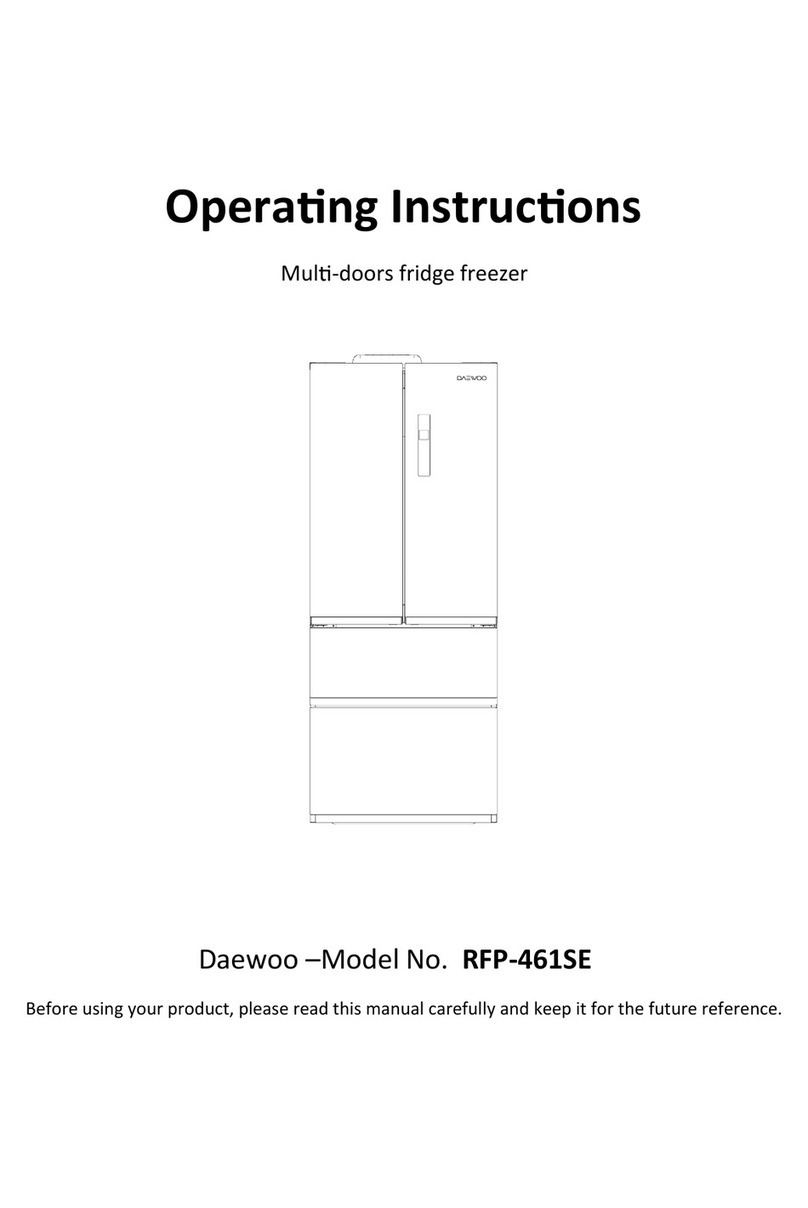
Daewoo
Daewoo RFP-461SE User manual
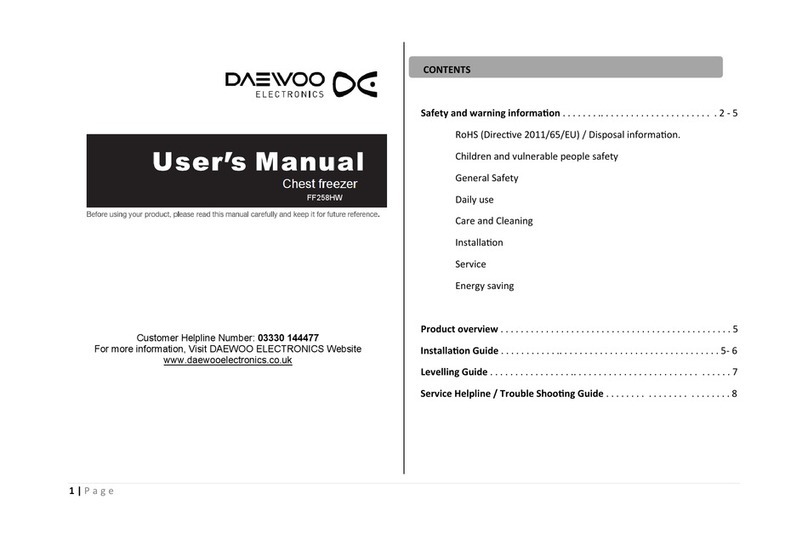
Daewoo
Daewoo FF258HW User manual
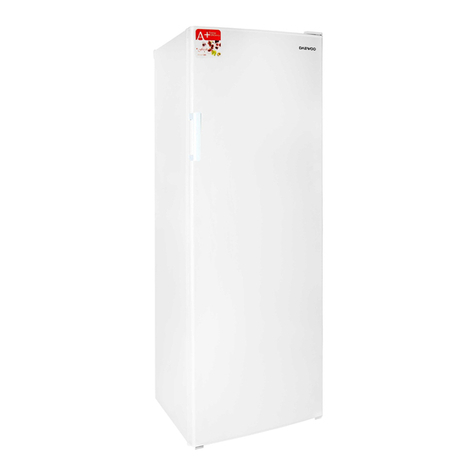
Daewoo
Daewoo FF311VP User manual
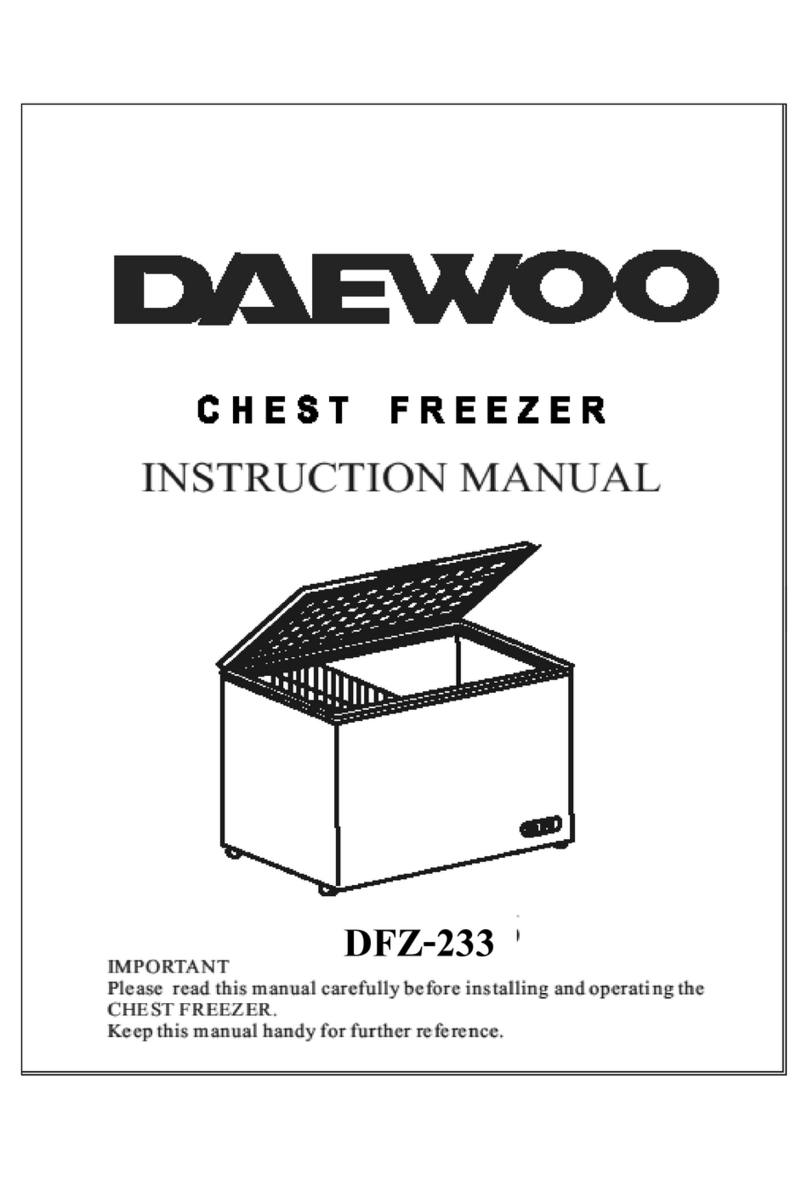
Daewoo
Daewoo DFZ-233 User manual
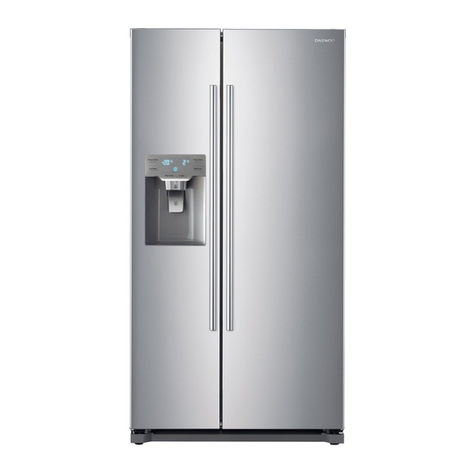
Daewoo
Daewoo FRAG53NP7B User manual

Daewoo
Daewoo RN-171NB User manual

Daewoo
Daewoo FFN278EWR0ES User manual
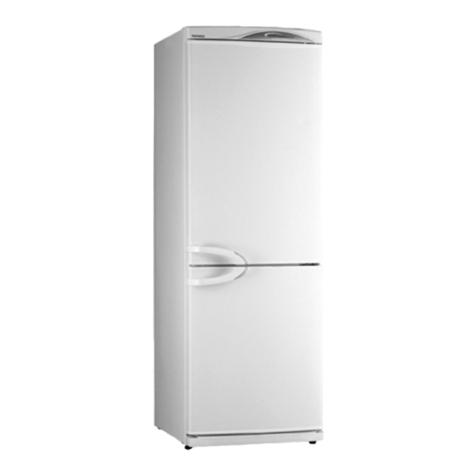
Daewoo
Daewoo ERF-40.M User manual
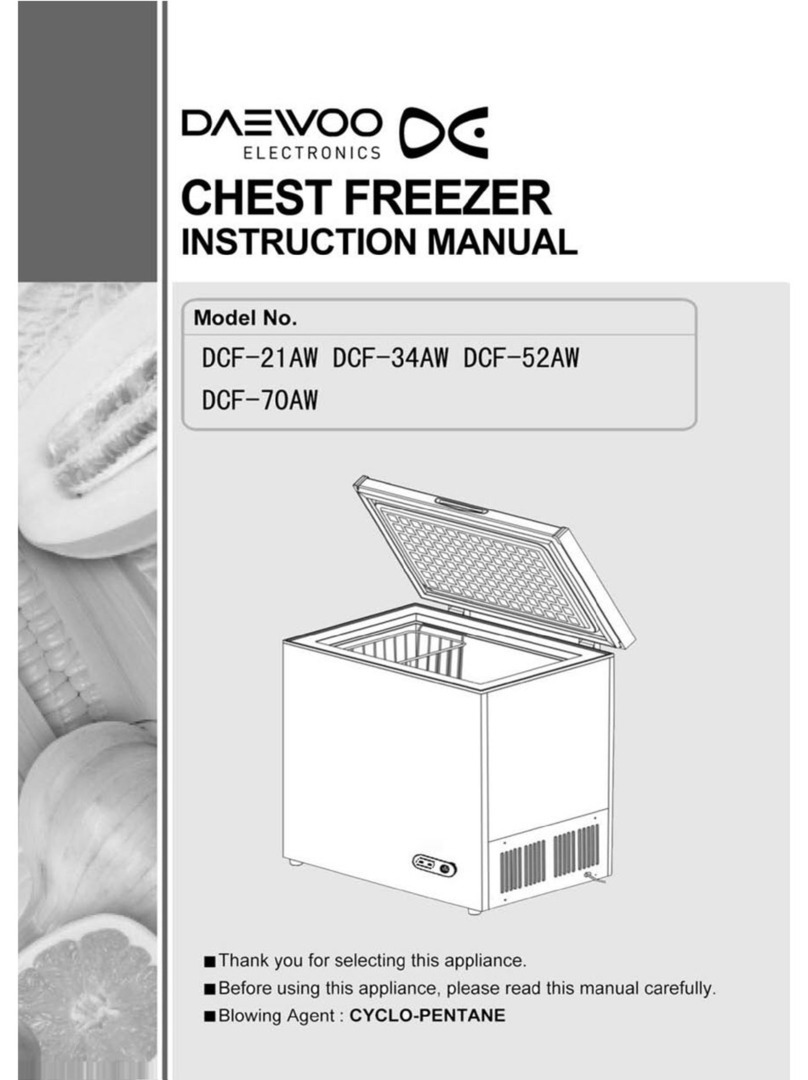
Daewoo
Daewoo DCF-21AW User manual
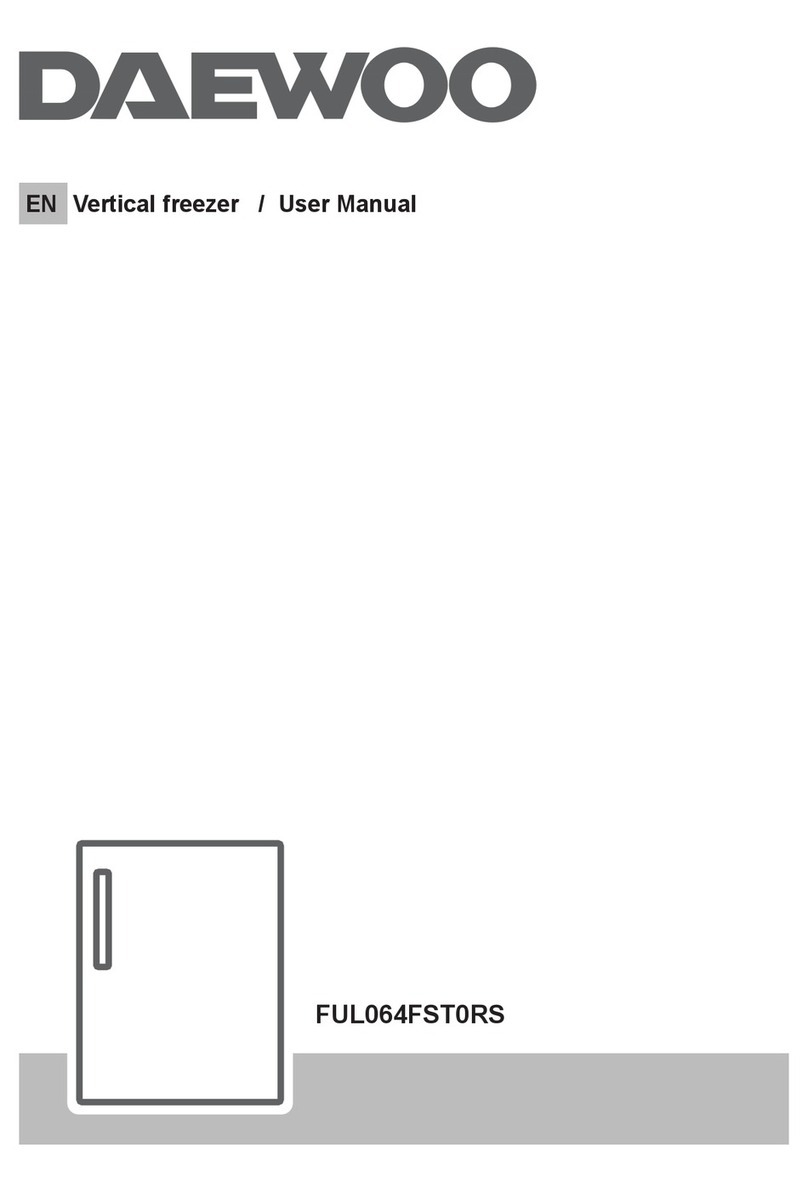
Daewoo
Daewoo FUL064FST0RS User manual
